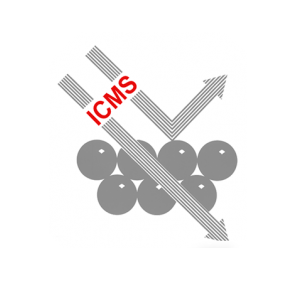Artículos SCI
2016
2016
Materiales Avanzados
Ceramics from clays and by-product from biodiesel production: Processing, properties and microstructural characterization
Martinez-Martinez, S; Perez-Villarejo, L; Eliche-Quesada, D; Carrasco-Hurtado, B; Sanchez-Soto, PJ; Angelopoulos, GNApplied Clay Science, 121 (2016) 119-126 DOI: 10.1016/j.day.2015.12.003

Abstract
The production of biodiesel generates a by-product called glycerine which contains glycerol that cannot be reintegrated into the same manufacturing process. The ceramic bricks are an interesting option to set in their structure a wide range of by-products and residues materials and composites, sometimes serving only as a reservoir for the inert residue, and other, having a positive effect on the ceramic material or process. In the present work, the incorporation of this waste in raw clays has been studied. The raw materials: clay and glycerine was characterized by XRD, XRF, CNHS analysis, higher heating value and thermal analysis and after, using conventional moulding and sintering processing methods to prepare clay-glycerine composites, the influence of the amount of waste added to clay has been evaluated. To do this, percentages of glycerine were added to the clay from 5% to 20% and evaluated by a series of technological properties such as compressive strength, absorption and suction of water, bulk density, the study of porosity generated by adsorption-desorption isotherms of N-2, thermal conductivity and finally by the compressive strength after freezing-thaw, it was considered as the maximum permissible rate of addition of glycerol 10-15% in weight, because higher additions have a strong effect on the properties of the obtained materials such as compression strength and bulk density which descending dramatically due to the large amount of porosity generated as reflected by high values of absorption and suction experiments. It was concluded that adding 5% glycerol to the ceramic paste generated plasticity in clay to achieve be moulded, with values of compressive strength of 84 MPa while gets to reduce the density apparent by almost.
Marzo, 2016 · DOI: 10.1016/j.day.2015.12.003
Materiales de Diseño para la Energía y Medioambiente
Active metal brazing of silicon nitride ceramics using a Cu-based alloy and refractory metal interlayers
Fernandez, JM; Asthana, R; Singh, M; Valera, FMCeramics International, 42 (2016) 5447-5454 DOI: 10.1016/j.ceramint.2015.12.087
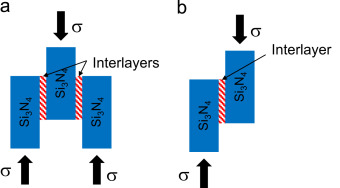
Abstract
Silicon nitride/silicon nitride joints with refractory metal (W and Mo) interlayers were vacuum brazed using an active braze, Cu-ABA (Cu-3Si-2Al-2.25Ti, wt%), and two interlayer arrangements in a double-lap offset configuration: Si3N4/Cu-ABA/W/Cu-ABA/Mo/Cu-ABA/Si3N4 and Si3N4/Cu-ABA /Si3N4. Titanium segregated at the Si3N4/Cu-ABA and Mo/Cu-ABA interfaces, but not at the W/Cu-ABA interface. The room-temperature compression-shear strength values of Si3N4/Cu-ABA/Si3N4 and Si3N4/Cu-ABA/W/Cu-ABA/Mo/Cu-ABA/Si3N4 joints were 118 +/- 24 MPa and 22 +/- 5 MPa, respectively. Elevated-temperature compression tests showed that Si3N4/Cu-ABA/Si3N4 joints had strength of 31 +/- 6 MPa at 1023 K and 17 +/- 3 MPa at 1073 K. Likewise, Si3N4/Cu-ABA/W/Cu-ABA/Mo/Cu-ABA/Si3N4 joints had strength of 19 +/- 4 MPa at 1023 K and 13 +/- 3 MPa at 1073 K. Knoop microhardness profiles revealed hardness gradients across the joints. The effect of joint microstructure and test configuration on the mechanical behavior is discussed.
Marzo, 2016 · DOI: 10.1016/j.ceramint.2015.12.087
Química de Superficies y Catálisis - Reactividad de Sólidos
Intensification of hydrogen production by methanol steam reforming
Sanz, O; Velasco, I; Perez-Miqueo, I; Poyato, R; Odriozola, JA; Montes, MInternational Journal Hydrogen Energy, 41 (2016) 5250-5259 DOI: 10.1016/j.ijhydene.2016.01.084
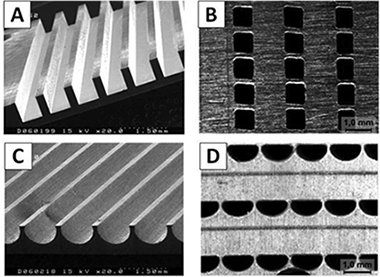
Abstract
This paper studies the methanol steam reforming intensification to enhance the hydrogen production in a multi-channel block type micro-reformer. The effects of operating parameters such as reforming temperature, space velocity and catalyst layer thickness on reforming performance are investigated. For optimized design and operating conditions, the 8 cm(3) reformer unit produced 170 LH2/h containing on dry basis 75.0% H-2, 23.5% CO2, 0.06% CH3OH and 1.44% CO at 648 K allowing the production of 218-255 Win a commercial PEMFC with 80% hydrogen utilization. This study shows that high methanol conversion can be achieved with high Pd/ZnO catalyst loading at 648 K with very low CO content (<1.5%) in the outlet stream.
Marzo, 2016 · DOI: 10.1016/j.ijhydene.2016.01.084
Materiales y Procesos Catalíticos de Interés Ambiental y Energético
TiO2-clay based nanoarchitectures for enhanced photocatalytic hydrogen production
Perez-Carvajal, J; Aranda, P; Obregon, S; Colon, G; Ruiz-Hitzky, EMicroporous and Mesoporous Materials, 222 (2016) 120-127 DOI: 10.1016/j.micromeso.2015.10.007
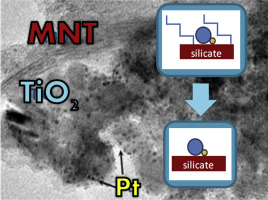
Abstract
New functional TiO2-clay nanoarchitectures based on layered and fibrous silicates and incorporating Pd and Pt noble metal nanoparticles (NPs) have been synthesized by applying a sol–gel methodology that involves the use of commercial organoclays. The incorporation of the noble metal NPs can be done using two different approaches: i) direct addition to the synthesis medium of a noble metal precursor (typically acetylacetonate) during the generation of the nanoarchitecture, and ii) selective photodeposition of the noble metal NPs in a post-treatment of the TiO2-clay nanoarchitecture. The resulting materials have been characterized by means of XRD, FTIR, Raman, 29Si-NMR, FE-SEM, TEM and N2 adsorption–desorption isotherms. The efficiency of these nanoarchitectures in the photocatalytic hydrogen production has been tested in the photoreforming of methanol. The higher rate in the hydrogen production corresponds to the nanoarchitectures containing Pt and TiO2 NPs derived from sepiolite.
Marzo, 2016 · DOI: 10.1016/j.micromeso.2015.10.007
Nanotecnología en Superficies y Plasma
Characterization and application of a new pH sensor based on magnetron sputtered porous WO3 thin films deposited at oblique angles
Salazar, P; Garcia-Garcia, FJ; Yubero, F; Gil-Rostra, J; Gonzalez-Elipe, ARElectrochimica Acta, 193 (2016) 24-31 DOI: 10.1016/j.electacta.2016.02.040
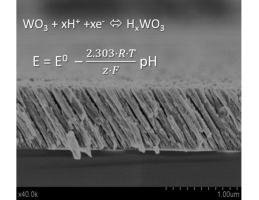
Abstract
In this communication we report about an outstanding solid-state pH sensor based on amorphous nanocolumnar porous thin film electrodes. Transparent WO3 thin films were deposited by reactive magnetron sputtering in an oblique angle configuration to enhance their porosity onto indium tin oxide (ITO) and screen printed electrodes (SPE). The potentiometric pH response of the nanoporous WO3-modified ITO electrode revealed a quasi-Nernstian behaviour, i.e. a linear working range from pH 1 to 12 with a slope of about -57.7 mV/pH. pH detection with this electrode was quite reproducible, displayed excellent anti-interference properties and a high stable response that remained unaltered over at least 3 months. Finally, a pH sensor was developed using nanoporous WO3-modified screen printed electrode (SPE) using a polypyrrole-modified Ag/AgCl electrode as internal reference electrode. This full solid state pH sensor presented a Nernstian behaviour with a slope of about -59 mV/pH and offered important analytical and operation advantages for decentralized pH measurements in different applications.
Marzo, 2016 · DOI: 10.1016/j.electacta.2016.02.040
Química de Superficies y Catálisis
In-situ Raman spectroscopy study of Ru/TiO2 catalyst in the selective methanation of CO
Martinez Tejada, LM; Munoz, A; Centeno, MA; Odriozola, JAJournal of Raman Spectroscopy, 47 (2016) 189-197 DOI: 10.1002/jrs.4774
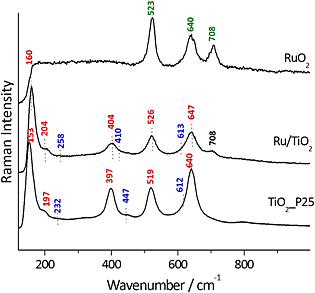
Abstract
Raman spectroscopic technique has been used to characterize a Ru/TiO2 catalyst and to follow in situ their structural changes during the CO selective methanation reaction (S-MET). For a better comprehension of the catalytic mechanism, the in-situ Raman study of the catalysts activation (reduction) process, the isolated CO and CO2 methanation reactions and the effect of the composition of the reactive stream (H2O and CO2 presence) have been carried out. Raman spectroscopy evidences that the catalyst is composed by islands of TiO2-RuO2 solid solutions, constituting Ru-TiO2 interphases in the form of RuxTi1-xO2 rutile type solid solutions. The activation procedure with H-2 at 300 degrees C promotes the reduction of the RuO2-TiO2 islands generating Ru-o-Ti3+ centers. The spectroscopic changes are in agreement with the strong increase in chemical reactivity as increasing the carbonaceous intermediates observed. The selective methanation of CO proceeds after their adsorption on these Ru-o-Ti3+ active centers and subsequent C?O dissociation throughout the formation of CHx/CnHx/CnHxO/CHx?CO species. These intermediates are transformed into CH4 by a combination of hydrogenation reactions. The formation of carbonaceous species during the methanation of CO and CO2 suggests that the CO presence is required to promote the CO2 methanation. Similar carbonaceous species are detected when the selective CO methanation is carried out with water in the stream. However, the activation of the catalysts occurs at much lower temperatures, and the carbon oxidation is favored by the oxidative effect of water.
Febrero, 2016 · DOI: 10.1002/jrs.4774
Materiales Ópticos Multifuncionales
Photophysical Analysis of the Formation of Organic–Inorganic Trihalide Perovskite Films: Identification and Characterization of Crystal Nucleation and Growth
Anaya, M; Galisteo-Lopez, JF; Calvo, ME; Lopez, C; Miguez, HJournal of Physical Chemistry C, 120 (2016) 3071-3076 DOI: 10.1021/acs.jpcc.6b00398
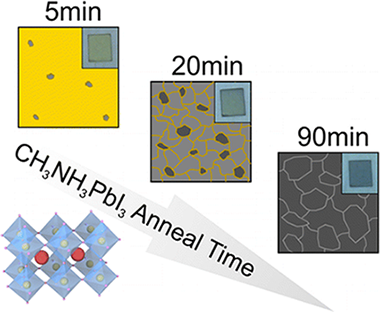
Abstract
In this work we demonstrate that the different processes occurring during hybrid organic–inorganic lead iodide perovskite film formation can be identified and analyzed by a combined in situ analysis of their photophysical and structural properties. Our observations indicate that this approach permits unambiguously identifying the crystal nucleation and growth regimes that lead to the final material having a cubic crystallographic phase, which stabilizes to the well-known tetragonal phase upon cooling to room temperature. Strong correlation between the dynamic and static photoemission results and the temperature-dependent X-ray diffraction data allows us to provide a description and to establish an approximate time scale for each one of the stages and their evolution. The combined characterization approach herein explored yields key information about the kinetics of the process, such as the link between the evolution of the defect density during film formation, revealed by a fluctuating photoluminescence quantum yield, and the gradual changes observed in the PbI2-related precursor structure.
Febrero, 2016 · DOI: 10.1021/acs.jpcc.6b00398
Reactividad de Sólidos
Synthesis and characterization of CuInS2 nanocrystalline semiconductor prepared by high-energy milling
Dutkova, E; Sayagues, MJ; Briancin, J; Zorkovska, A; Bujnakova, Z; Kovac, J; Kovac, J; Balaz, P; Ficeriova, JJournal of Materials Science, 51 (2016) 1978-1984 DOI: 10.1007/s10853-015-9507-x
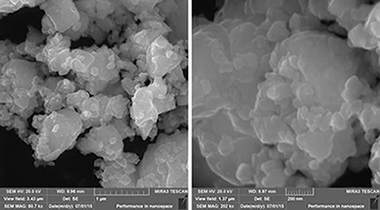
Abstract
Nanocrystalline CuInS2 particles have been synthesized from copper, indium, and sulfur powders by high-energy milling in a planetary mill in an argon atmosphere. Structural characterization of the prepared nanoparticles, including phase identification, Raman spectroscopy, specific surface area measurement, and particle size analysis were performed. The optical properties were studied using UV-Vis absorption and photoluminescence (PL) spectroscopy. The production of CuInS2 (JCPDS 027-0159) particles with a crystallite size of about 17.5-23.5 nm was confirmed by X-ray diffraction. The crystal structure has a tetragonal body-centered symmetry belonging to the I-42d space group. The Raman spectra also proved the formation of pure CuInS2 nanoparticles. TEM and HRTEM measurements revealed the presence of nanoparticles of different dimensions (10-20 nm) and their tendency to form agglomerates. The nanoparticles tend to agglomerate due to their large specific surface area. The average size of the synthesized particles was determined by photon cross-correlation spectroscopy to be in the range of 330-530 nm (bimodal size distribution). The band gap of the CuInS2 particles is 2 eV which is wider than that in bulk materials. The decrease in size leads to the blue-shift of the PL spectra. Therefore, CuInS2 nanoparticles are promising candidates for optical applications, and they have high potential in solar energy conversion.
Febrero, 2016 · DOI: 10.1007/s10853-015-9507-x
Nanotecnología en Superficies y Plasma
Ripening and recrystallization of NaCl nanocrystals in humid conditions
Oliva-Ramirez, M; Macias-Montero, M; Borras, A; Gonzalez-Elipe, ARRSC Advances, 6 (2016) 3778-3782 DOI: 10.1039/C5RA22425J

Abstract
This study shows that Ostwald ripening, a universal mechanism responsible for the increase of crystal size during precipitation from solutions, can be meditated by ion diffusion through condensed monolayers of water that connect separated nanocrystals. In an environmental electron microscope we have observed "in situ" the time evolution of the number, shape, size and crystallographic texture of NaCl nanoparticles deposited by electron beam evaporation at oblique angles. Analysis of NaCl nanoparticles before and after water vapor condensation has evidenced that the size of nanocrystals is not the unique driving force inducing nanoparticle ripening and recrystallization, but the faceting of their crystalline habits and the amorphisation degree of the initially deposited nuclei also play important roles. These findings have implications for other crystallization and nucleation processes and can be of relevance for rock weathering and related phenomena.
Febrero, 2016 · DOI: 10.1039/C5RA22425J
Materiales Nanoestructurados y Microestructura
Determination of the Anisotropic Elastic Properties of Rocksalt Ge2Sb2Te5 by XRD, Residual Stress, and DFT
Cecchini, R; Kohary, K; Fernandez, A; Cabibbo, M; Marmier, AJournal of Physical Chemistry C, 120 (2016) 5624-5629 DOI: 10.1021/acs.jpcc.5b09867
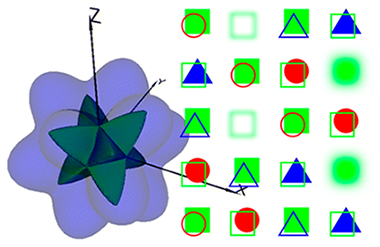
Abstract
The chalcogenide material Ge2Sb2Te5 is the prototype phase-change material, with widespread applications for optical media and random access memory. However, the full set of its independent elastic properties has not yet been published. In this study, we determine the elastic constants of the rocksalt Ge2Sb2Te5, experimentally by X-ray diffraction (XRD) and residual stress and computationally by density functional theory (DFT). The stiffnesses (XRD-stress/DFT) in GPa are C-11 = 41/58, C-12 = 7/8, and C-44 = 8/12, and the Zener ratio is 0.46/0.48. These values are important to understand the effect of elastic distortions and nonmelting processes on the performances of increasingly small phase change data bits.
Febrero, 2016 · DOI: 10.1021/acs.jpcc.5b09867
Materiales Ópticos Multifuncionales
Maximized performance of dye solar cells on plastic: a combined theoretical and experimental optimization approach
Li, Yuelong; Carretero-Palacios, Sol; Yoo, Kicheon; Kim, Jong Hak; Jimenez-Solano, Alberto; Lee, Chul-Ho; Miguez, Hernan; Ko, Min JaeEnergy & Environmental Science, 9 (2016) 2061-2071 DOI: 10.1039/C6EE00424E
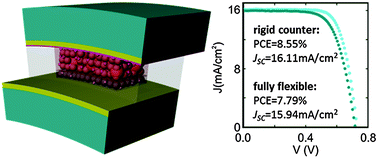
Abstract
We demonstrate that a combined optimization approach based on the sequential alternation of theoretical analysis and experimental realization gives rise to plastic supported dye solar cells for which both light harvesting efficiency and electron collection are maximized. Rationalized configurations with optimized light trapping and charge extraction are realized to achieve photoanodes on plastic prepared at low temperature, showing a power conversion efficiency of 8.55% and a short circuit photocurrent of 16.11 mA cm−2, unprecedented for plastic based dye solar cell devices. Furthermore, the corresponding fully flexible designs present stable mechanical properties after several bending cycles, displaying 7.79% power conversion efficiency, an average broadband internal quantum efficiency above 90%, and a short circuit photocurrent of 15.94 mA cm−2, which is the largest reported value for bendable cells of this sort to date.
Febrero, 2016 · DOI: 10.1039/C6EE00424E
Reactividad de Sólidos
Study by DSC and HRTEM of the aging strengthening of Cu-Ni-Zn-Al alloys
Dianez, MJ; Donoso, E; Criado, JM; Sayagues, MJ; Diaz, G; Olivares, LMaterials & Design, 92 (2016) 184-188 DOI: 10.1016/j.matdes.2015.12.030
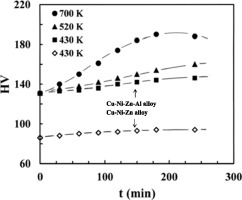
Abstract
The structural changes of a Cu-12 wt.% Ni-17 wt.% Zn-1.7 wt% Al alloy as a function of the aging temperature have been studied by means of Differential Scanning Calorimetry (DSC), high resolution transmission electron microscopy (HRTEM) and hardness measurements. It has been proposed a hardening mechanism that implies the crystallization of a Ll(0) Cu2NiZn phase coherent with the matrix a phase followed, firstly, by its transformation into a Ll(2) coherent phase and, secondly, by the precipitation of this phase. It has been shown that aluminum play an important role in the precipitation hardening process because Cu2NiZn precipitates are not formed by aging a ternary Cu-Ni-Zn alloy of similar composition. It has been shown by the first time that DSC could be a powerful tool for discriminating the whole set of phase transformations undergone by alloys as a function of the annealing temperature from a single heating run.
Febrero, 2016 · DOI: 10.1016/j.matdes.2015.12.030
Química de Superficies y Catálisis
Ru-Ni Catalyst in the Combined Dry-Steam Reforming of Methane: The Importance in the Metal Order Addition
Alvarez, MA; Centeno, MA; Odriozola, JATopics in Catalysis, 59 (2016) 303-313 DOI: 10.1007/s11244-015-0426-5
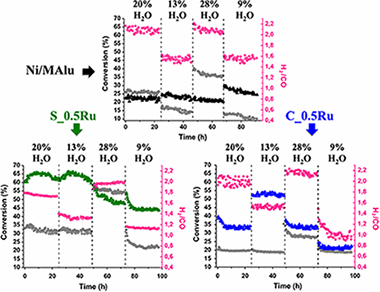
Abstract
Biogas is one of the main biomass-energy resources. Its use for syngas production with a H-2/CO ratio close to two would have huge environmental, social and economic impact in the actual energetic scenario. However, the use of dry reforming, where the two main components are transformed into syngas, does not allow the desired H-2/CO ratio. For this reason, the addition of water is proposed. The process was performed with two Ru-Ni catalysts where the metal order in the impregnation process was varied. The catalysts were prepared either by simultaneous or consecutive impregnation of the active phases and its catalytic performance in the combined dry-steam reforming of methane was tested. The catalysts were characterized by XRF, XRD, S-BET, TPR-H-2 and Raman spectroscopy. The existence of a strong Ni-Ru interaction is evidenced by Raman spectroscopy and TPR-H-2 in the sample synthesized by the simultaneous impregnation. Concerning the catalytic activity, this sample presents the highest CH4 and CO2 conversion values in the entire composition rate and the lowest amount of carbon deposits after reaction. After pulse, and reactivity tests it was concluded that the higher Ni-Ru interaction displayed by the catalyst synthesized by the simultaneous impregnation, enhances the carbon gasification.
Febrero, 2016 · DOI: 10.1007/s11244-015-0426-5
Nanotecnología en Superficies y Plasma
Vacuum template synthesis of multifunctional nanotubes with tailored nanostructured walls
Filippin, AN; Macias-Montero, M; Saghi, Z; Idigoras, J; Burdet, P; Barranco, A; Midgley, P; Anta, JA; Borras, AScientific Reports, 5 (2016) 20637 DOI: 10.1038/srep20637
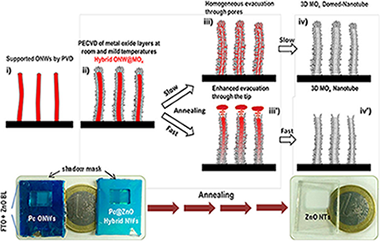
Abstract
A three-step vacuum procedure for the fabrication of vertical TiO2 and ZnO nanotubes with three dimensional walls is presented. The method combines physical vapor deposition of small-molecules, plasma enhanced chemical vapor deposition of inorganic functional thin films and layers and a post-annealing process in vacuum in order to remove the organic template. As a result, an ample variety of inorganic nanotubes are made with tunable length, hole dimensions and shapes and tailored wall composition, microstructure, porosity and structure. The fabrication of multishell nanotubes combining different semiconducting oxides and metal nanoparticles is as well explored. This method provides a feasible and reproducible route for the fabrication of high density arrays of vertically alligned nanotubes on processable substrates. The emptying mechanism and microstructure of the nanotubes have been elucidated through SEM, STEM, HAADF-STEM tomography and energy dispersive X-ray spectroscopy. In this article, as a proof of concept, it is presented the straightforward integration of ZnO nanotubes as photoanode in a photovoltaic cell and as a photonic oxygen gas sensor.
Febrero, 2016 · DOI: 10.1038/srep20637
Nanotecnología en Superficies y Plasma
Nanostructured Ti thin films by magnetron sputtering at oblique angles
Alvarez, R; Garcia-Martin, JM; Garcia-Valenzuela, A; Macias-Montero, M; Ferrer, FJ; Santiso, J; Rico, V; Cotrino, J; Gonzalez-Elipe, AR; Palmero, AJournal of Physics D-Applied Physics, 49 (2016) 045303 DOI: 10.1088/0022-3727/49/4/045303
Abstract
The growth of Ti thin films by the magnetron sputtering technique at oblique angles and at room temperature is analysed from both experimental and theoretical points of view. Unlike other materials deposited in similar conditions, the nanostructure development of the Ti layers exhibits an anomalous behaviour when varying both the angle of incidence of the deposition flux and the deposition pressure. At low pressures, a sharp transition from compact to isolated, vertically aligned, nanocolumns is obtained when the angle of incidence surpasses a critical threshold. Remarkably, this transition also occurs when solely increasing the deposition pressure under certain conditions. By the characterization of the Ti layers, the realization of fundamental experiments and the use of a simple growth model, we demonstrate that surface mobilization processes associated to a highly directed momentum distribution and the relatively high kinetic energy of sputtered atoms are responsible for this behaviour.
Febrero, 2016 · DOI: 10.1088/0022-3727/49/4/045303
Nanotecnología en Superficies y Plasma
Nanoindentation and scratch resistance of multilayered TiO2-SiO2 coatings with different nanocolumnar structures deposited by PV-OAD
Roa, JJ; Rico, V; Oliva-Ramirez, M; Gonzalez-Elipe, AR; Jimenez-Pique, EJournal of Physics D-Applied Physics, 49 (2016) 13 DOI: 10.1088/0022-3727/49/13/135104
Abstract
This paper presents a study of the mechanical properties and an evaluation of damage mechanisms of nanocolumnar TiO2-SiO2 multilayer coatings prepared by physical vapour oblique angle deposition at different configurations (slanted, zigzag or chiral) and two zenithal evaporation angles (70 degrees or 85 degrees). The characterization at micro-and nanometric length scales of the mechanical properties of the multilayers has been carried out by nanoindentation and nanoscratch tests, while the morphological evaluation of the surface and sub-surface damages produced with a sharp indenter and the adhesive and/or cohesive failures between coating and substrate have been investigated by field emission scanning electron microscopy and focused ion beam, respectively. The obtained results have shown that the main processing parameters controlling the mechanical response of the different multilayers is the zenithal angle of deposition and the number of layers in the multilayer stack, while the coating architecture had only a minor effect on the mechanical response. This analysis also revealed a higher resistance to scratch testing and a brittle failure behaviour for the low zenithal angle coatings as compared with the high angle ones.
Febrero, 2016 · DOI: 10.1088/0022-3727/49/13/135104
Nanotecnología en Superficies y Plasma
Application of Prussian Blue electrodes for amperometric detection of free chlorine in water samples using Flow Injection Analysis
Salazar, P; Martin, M; Gonzalez-Mora, JL; Gonzalez-Elipe, ARTalanta, 146 (2016) 410-416 DOI: 10.1016/j.talanta.2015.08.072
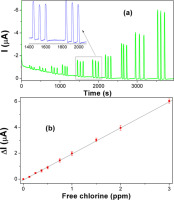
Abstract
The performance for free chlorine detection of surfactant-modified Prussian Blue screen printed carbon electrodes (SPCEs/PB-BZT) have been assessed by cyclic voltammetry and constant potential amperometry. The characterization of SPCEs/PB-BZT by X-ray photoemission, Raman and infrared spectroscopies confirmed the correct electrodeposition of the surfactant-modified PB film. These electrodes were incorporated in a Flow Injection device and the optimal working conditions determined as a function of experimental variables such as detection potential, electrolyte concentration or flow-rate. The sensor presented a linear response in the range 0–3 ppm free chlorine, with a sensitivity of 16.2 μA ppm−1 cm−2. The limit of detection (LOD) (S/N=3.3) and the limit of quantification (S/N=10) amounted to 8.25 and 24.6 ppb, respectively, adequate for controlling tap and drinking waters. To demonstrate the feasibility of using this free chlorine sensor for real applications possible interferences such as nitrate, nitrite and sulfate ions were successfully tested and discarded. Real free chlorine analysis was carried out in spiked tap water samples and commercial bleaches.
Enero, 2016 · DOI: 10.1016/j.talanta.2015.08.072
Nanotecnología en Superficies y Plasma - Tribología y Protección de Superficies
Highly Porous ZnO Thin Films and 1D Nanostructures by Remote Plasma Processing of Zn-Phthalocyanine
Alcaire, M; Filippin, AN; Macias-Montero, M; Sanchez-Valencia, JR; Rojas, TC; Mora-Boza, A; Lopez-Santos, C; Espinos, JP; Barranco, A; Borras, APlasma Processes and Polymers, 13 (2016) 287-297 DOI: 10.1002/ppap.201500133
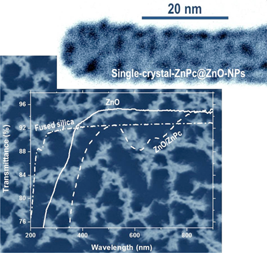
Abstract
In this paper the fabrication of highly porous 1D nanostructures by a vacuum and plasma etching combined protocol is presented. Zn-phthalocyanine (ZnPc) is utilized as a solid precursor to form the ZnO. First the ZnPc is sublimated in low argon pressure. Depending on the substrate temperature and microstructure, polycrystalline films or single crystal ZnPc nanowires are grown. These starting materials are then subjected to a remote plasma oxidizing treatment. Experimental parameters such as substrate position, plasma power, treatment duration, and substrate temperature determine the microstructure and properties of the final ZnO nanostructures. The article gathers an in depth study of the obtained porous nanostructured films following scanning and transmission electron microscopy (SEM and TEM), X-ray photoelectron spectroscopy (XPS), X-ray Diffraction (XRD), UV-Vis transmittance, and fluorescence spectroscopies.
Enero, 2016 · DOI: 10.1002/ppap.201500133
Materiales Coloidales
Ligand-Free Synthesis of Tunable Size Ln:BaGdF5 (Ln = Eu3+ and Nd3+) Nanoparticles: Luminescence, Magnetic Properties, and Biocompatibility
Becerro, AI; Gonzalez-Mancebo, D; Cantelar, E; Cusso, F; Stepien, G; de la Fuente, JM; Ocana, MLangmuir, 32 (2016) 411-420 DOI: 10.1021/acs.langmuir.5b03837
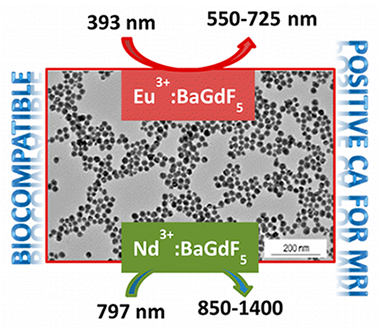
Abstract
Bifunctional and highly uniform Ln:BaGdF5 (Ln = Eu3+ and Nd3+) nanoparticles have been successfully synthesized using a solvothermal method consisting of the aging at 120 degrees C of a glycerol solution containing the corresponding Lanthanide acetylacetonates and butylmethylimidazolium tetrafluoroborate. The absence of any surfactant in the synthesis process rendered hydrophilic nanospheres (with tunable diameter from 45 nm 85 nm, depending on the cations concentration of the starting solution) which are suitable for bioapplications. The particles are bifunctional because they showed both optical and magnetic properties due to the presence of the optically active lanthanides (Eu3+ in the visible and Nd3+ in the NIR regions of the electromagnetic spectrum) and the paramagnetic gadolinium ion, respectively. The luminescence decay curves of the nanospheres doped with different amounts of Eu3+ and Nd3+ have been recorded in order to determine the optimum dopant concentration in each case, which turned out to be 5% Eu3+ and 0.5% Nd3+. Likewise, proton relaxation times were measured at 1.5 T in water suspensions of the optimum particles found in the luminescence study. The values obtained suggested that both kinds of particles could be used as positive contrast agents for MRI. Finally, it was demonstrated that both the 5% Eu3+ and 0.5% Nd3+-doped BaGdF5 nanospheres showed negligible cytotoxicity for VERO cells for concentrations up to 0.25 mg mL(-1).
Enero, 2016 · DOI: 10.1021/acs.langmuir.5b03837
Materiales Coloidales
Deposition of silica protected luminescent layers of Eu:GdVO4 nanoparticles assisted by atmospheric pressure plasma jet
Moretti, E; Pizzol, G; Fantin, M; Enrichi, F; Scopece, P; Nunez, NO; Ocana, M; Benedetti, A; Polizzi, SThin Solid Films, 598 (2016) 88-94 DOI: 10.1016/j.tsf.2015.11.061
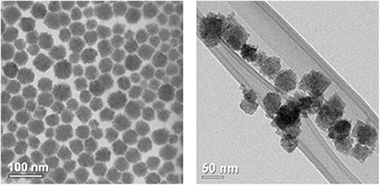
Abstract
Eu:GdVO4 nanophosphors with an average size of 60 nm, synthesized by a facile solvothermal method, were deposited on monocrystalline silicon wafers by a spray-coating technique with artworks anti-counterfeiting applications in mind. Atmospheric pressure plasma jet (APPJ) was used to deposit a silica-based layer on top of the nanometric luminescent layer, in order to improve its adhesion to the substrate and to protect it from the environment. The nanophosphors were characterized by X-ray diffraction (XRD) and transmission electron microscopy (TEM). Coating composition was investigated by Fourier transform infrared spectroscopy (FT-IR) and its morphology was characterized by scanning electron microscopy (FEG-SEM). The film thickness was evaluated by means of ellipsometry and adhesion was estimated by a peeling test. Luminescent properties of the nanophosphors deposited and fixed on silicon wafers were also measured. The whole layer resulted well-adhered to the silicon substrate, transparent and undetectable in the presence of visible light, but easily activated by UV light source.
Enero, 2016 · DOI: 10.1016/j.tsf.2015.11.061
Materiales Nanoestructurados y Microestructura
Disorder-order phase transformation in a fluorite-related oxide thin film: In-situ X-ray diffraction and modelling of the residual stress effects
Gaboriaud, RJ; Paumier, F; Lacroix, BThin Solid Films, 601 (2016) 84-88 DOI: 10.1016/j.tsf.2015.08.030
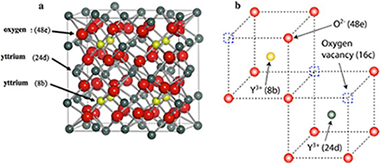
Abstract
This work is focused on the transformation of the disordered fluorite cubic-F phase to the ordered cubic-C bixbyite phase, induced by isothermal annealing as a function of the residual stresses resulting from different concentrations of microstructural defects in the yttrium oxide, Y2O3.
This transformation was studied using in-situ X-ray diffraction and was modelled using Kolmogorov-Johnson-Mehl-Avrami (KJMA) analysis. The degree of the disorder of the oxygen network was associated with the residual stress, which was a key parameter for the stability and the kinetics of the transition of the different phases that were present in the thin oxide film. When the degree of disorder/residual stress level is high, this transition, which occurs at a rather low temperature (300 degrees C), is interpreted as a transformation of phases that occurs by a complete recrystallization via the nucleation and growth of a new cubic-C structure. Using the KJMA model, we determined the activation energy of the transformation process, which indicates that this transition occurs via a one-dimensional diffusion process. Thus, we present the analysis and modelling of the stress state. When the disorder/residual stress level was low, a transition to the quasi-perfect ordered cubic-C structure of the yttrium oxide appeared at a rather high temperature (800 degrees C), which is interpreted as a classic recovery mechanism of the cubic-C structure.
Enero, 2016 · DOI: 10.1016/j.tsf.2015.08.030
Materiales Coloidales
Gold-Based Nanomaterials for Applications in Nanomedicine
Ashraf, S; Pelaz, B; del Pino, P; Carril, M; Escudero, A; Parak, WJ; Soliman, MG; Zhang, Q; Carrillo-Carrion, CLight-Responsive Nanostructured Systems for Applications in Nanomedicine, 370 (2016) 169-202 DOI: http://link.springer.com/chapter/10.1007%2F978-3-319-22942-3_6
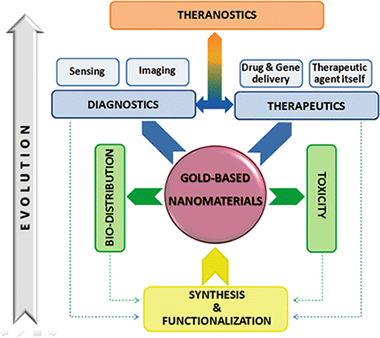
Abstract
In this review, an overview of the current state-of-the-art of gold-based nanomaterials (Au NPs) in medical applications is given. The unique properties of Au NPs, such as their tunable size, shape, and surface characteristics, optical properties, biocompatibility, low cytotoxicity, high stability, and multifunctionality potential, among others, make them highly attractive in many aspects of medicine. First, the preparation methods for various Au NPs including functionalization strategies for selective targeting are summarized. Second, recent progresses on their applications, ranging from the diagnostics to therapeutics are highlighted. Finally, the rapidly growing and promising field of gold-based theranostic nano-platforms is discussed. Considering the great body of existing information and the high speed of its renewal, we chose in this review to generalize the data that have been accumulated during the past few years for the most promising directions in the use of Au NPs in current medical research.
Enero, 2016 · DOI: http://link.springer.com/chapter/10.1007%2F978-3-319-22942-3_6
Materiales Nanoestructurados y Microestructura
Investigation of a Pt containing washcoat on SiC foam for hydrogen combustion applications
Fernandez, A; Arzac, GM; Vogt, UF; Hosoglu, F; Borgschulte, A; de Haro, MCJ; Montes, O; Zuttel, AApplied Catalysis B: Environmental, 180 (2016) 336-343 DOI: 10.1016/j.apcatb.2015.06.040
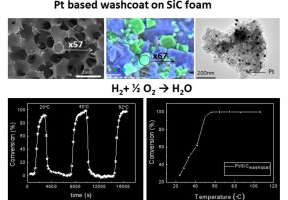
Abstract
A commercial Pt based washcoat, used for catalytic methane combustion, was studied supported on a commercial SiC foam as catalytic material (Pt/SiC) for catalytic hydrogen combustion (CHC). Structural and chemical characterization was performed using Electron Microscopy, X-Ray Diffraction (XRD) and X-Ray Photoelectron Spectroscopy (XPS). The reaction was monitored following water concentration by Fourier Transform Infrared spectra (FTIR). The FTIR method was compared with H2 detection by Gas Cromatography (GC) and has shown to be adequate to study the kinetics of the CHC reaction in steady state under our experimental conditions (very lean 1% (v/v) H2/air mixtures). The catalyst is composed of 5–20 nm disperse Pt nanoparticles decorating a mixture of high surface area Al2O3 and small amounts of ceria supported on the SiC foam which also contains alumina as binder. The Pt/SiC catalytic material has demonstrated to be active enough to start up the reaction in a few seconds at room temperature. The material has been able to convert at least 18.5 Lhydrogen min−1 gPt−1 at room temperature in conditions of excess of catalyst. The Pt/SiC material was studied after use using XPS and no significant changes on Pt oxidation states were found. The material was characterized from a kinetic point of view. From the conversion-temperature plot a T50(temperature for 50% conversion) of 34 °C was obtained. Activation energy measured in our conditions was 35 ± 1 kJ mol−1.
Enero, 2016 · DOI: 10.1016/j.apcatb.2015.06.040
Reactividad de Sólidos
The Calcium-Looping technology for CO2 capture: On the important roles of energy integration and sorbent behavior
Perejon, A; Romeo, LM; Lara, Y; Lisbona, P; Martinez, A; Valverde, JMApplied Energy, 162 (2016) 787-807 DOI: 10.1016/j.apenergy.2015.10.121
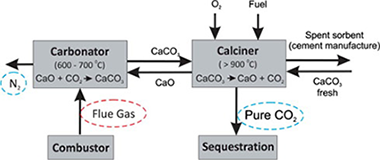
Abstract
The Calcium Looping (CaL) technology, based on the multicyclic carbonation/calcination of CaO in gas-solid fluidized bed reactors at high temperature, has emerged in the last years as a potentially low cost technology for CO2 capture. In this manuscript a critical review is made on the important roles of energy integration and sorbent behavior in the process efficiency. Firstly, the strategies proposed to reduce the energy demand by internal integration are discussed as well as process modifications aimed at optimizing the overall efficiency by means of external integration. The most important benefit of the high temperature CaL cycles is the possibility of using high temperature streams that could reduce significantly the energy penalty associated to CO2 capture. The application of the CaL technology in precombustion capture systems and energy integration, and the coupling of the CaL technology with other industrial processes are also described. In particular, the CaL technology has a significant potential to be a feasible CO2 capture system for cement plants. A precise knowledge of the multicyclic CO2 capture behavior of the sorbent at the CaL conditions to be expected in practice is of great relevance in order to predict a realistic capture efficiency and energy penalty from process simulations. The second part of this manuscript will be devoted to this issue. Particular emphasis is put on the behavior of natural limestone and dolomite, which would be the only practical choices for the technology to meet its main goal of reducing CO2 capture costs. Under CaL calcination conditions for CO2 capture (necessarily implying high CO2 concentration in the calciner), dolomite seems to be a better alternative to limestone as CaO precursor. The proposed techniques of recarbonation and thermal/mechanical pretreatments to reactivate the sorbent and accelerate calcination will be the final subjects of this review.
Enero, 2016 · DOI: 10.1016/j.apenergy.2015.10.121
Nanotecnología en Superficies y Plasma
A novel 3D absorption correction method for quantitative EDX-STEM tomography
Burdet, P; Saghi, Z; Filippin, AN; Borras, A; Midgley, PAUltramicroscopy, 160 (2016) 118-129 DOI: 10.1016/j.ultramic.2015.09.012
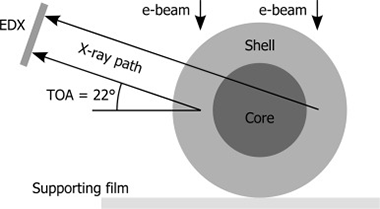
Abstract
This paper presents a novel 3D method to correct for absorption in energy dispersive X-ray (EDX) microanalysis of heterogeneous samples of unknown structure and composition. By using STEM-based tomography coupled with EDX, an initial 3D reconstruction is used to extract the location of generated X-rays as well as the X-ray path through the sample to the surface. The absorption correction needed to retrieve the generated X-ray intensity is then calculated voxel-by-voxel estimating the different compositions encountered by the X-ray. The method is applied to a core/shell nanowire containing carbon and oxygen, two elements generating highly absorbed low energy X-rays. Absorption is shown to cause major reconstruction artefacts, in the form of an incomplete recovery of the oxide and an erroneous presence of carbon in the shell. By applying the correction method, these artefacts are greatly reduced. The accuracy of the method is assessed using reference X-ray lines with low absorption.
Enero, 2016 · DOI: 10.1016/j.ultramic.2015.09.012
Nanotecnología en Superficies y Plasma
Optofluidic Modulation of Self-Associated Nanostructural Units Forming Planar Bragg Microcavities
Oliva-Ramirez, M; Barranco, A; Loffler, M; Yubero, F; Gonzalez-Elipe, ARACS Nano, 10 (2016) 1256-1264 DOI: 10.1021/acsnano.5b06625
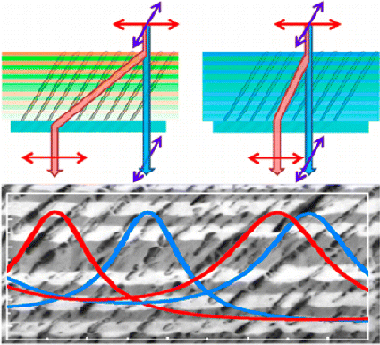
Abstract
Bragg microcavities (BMs) formed by the successive stacking of nanocolumnar porous SiO2 and TiO2 layers with slanted, zigzag, chiral, and vertical configurations are prepared by physical vapor deposition at oblique angles while azimuthally varying the substrate orientation during the multilayer growth. The slanted and zigzag BMs act as wavelength-selective optical retarders when they are illuminated with linearly polarized light, while no polarization dependence is observed for the chiral and vertical cavities. This distinct optical behavior is attributed to a self-nanostructuration mechanism involving a fence-bundling association of nanocolumns as observed by focused ion beam scanning electron microscopy in the slanted and zigzag microcavities. The outstanding retarder response of the optically active BMs can be effectively modulated by dynamic infiltration of nano- and mesopores with liquids of different refraction indices acting as a switch of the polarization behavior. The unprecedented polarization and tunable optofluidic properties of these nanostructured photonic systems have been successfully simulated with a simple model that assumes a certain birefringence for the individual stacked layers and accounts for the light interference phenomena developed in the BMs. The possibilities of this type of self-arranged nanostructured and optically active BMs for liquid sensing and monitoring applications are discussed.
Enero, 2016 · DOI: 10.1021/acsnano.5b06625
Reactividad de Sólidos
High temperature oxidation resistance of (Ti,Ta)(C,N)-based cermets
Chicardi, E; Cordoba, JM; Gotor, FJCorrosion Science, 102 (2016) 125-136 DOI: 10.1016/j.corsci.2015.10.001
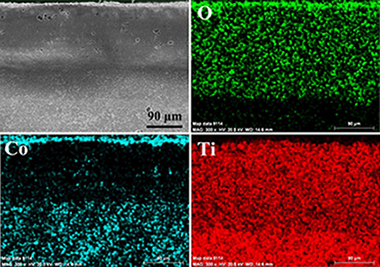
Abstract
Cermets based on titanium-tantalum carbonitride were oxidized in static air between 800 degrees C and 1100 degrees C for 48 h. The thermogravimetric and microstructural study showed an outstanding reduction in the oxidation of more than 90% when the Ta content was increased. In cermets with low Ta content, the formation of a thin CoO/Co3O4 outer layer tends to disappear by reacting with the underlying rutile phase, which emerges at the surface. However, in cermets with higher Ta content, the formation of an external titanate layer, observed even at a low temperature, appears to prevent the oxygen diffusion and the oxidation progression.
Enero, 2016 · DOI: 10.1016/j.corsci.2015.10.001
Reactividad de Sólidos
Influence of tin additions on the precipitation processes in a Cu-Ni-Zn alloys
Donoso, EC; Dianez, MJ; Criado, JM; Espinoza, R; Mosquera, ERevista de Metalurgia, 52 (2016) e060 DOI: 10.3989/revmetalm.060
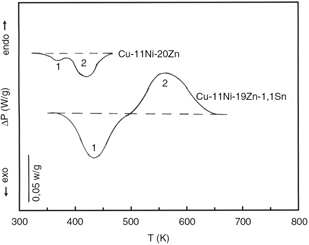
Abstract
Influence of tin additions on the precipitation processes in a Cu-Ni-Zn alloys. The influence of 1.1 wt% tin additions on the precipitation hardening of Cu-11 wt% Ni-20 wt% Zn alloy was studied by Differential Scanning Calorimetry (DSC), microhardeness measurements and High Resolution Transmission Electron Microscopy (HRTEM). The calorimetric curves, in the range of temperatures analyzed, show the presence of two exothermic reactions in the ternary alloy, associated to the short-range-order development assisted by migration of excess vacancies. On the other hand, one exothermic and one endothermic reaction are observed in the quaternary alloy, associated to the formation and dissolution of Cu2NiZn precipitates, respectively. It has been show that an addition of 1.1% tin plays an important role in the formation of Cu2NiZn precipitates, responsible for the precipitation hardening of the ternary alloy.
Enero, 2016 · DOI: 10.3989/revmetalm.060
Materiales Ópticos Multifuncionales
Efficient bifacial dye-sensitized solar cells through disorder by design
Miranda-Munoz, JM; Carretero-Palacios, S; Jimenez-Solano, A; Li, YL; Lozano, G; Miguez, HJournal of Materials Chemistry A, 4 (2016) 1953-1961 DOI: 10.1039/C5TA10091G

Abstract
Herein we realize an optical design that optimizes the performance of bifacial solar cells without modifying any of the usually employed components. In order to do so, dielectric scatterers of controlled size and shape have been successfully integrated in the working electrodes of dye-sensitized solar cells (DSSCs), resulting in bifacial devices of outstanding performance. Power conversion efficiencies (PCEs) as high as 6.7% and 5.4% have been attained under front and rear illumination, respectively, which represent a 25% and a 33% PCE enhancement with respect to an 8 μm-thick standard solar cell electrode using platinum as the catalytic material. The remarkable bifacial character of our approach is demonstrated by the high rear/front efficiency ratio attained, around 80%, which is among the largest reported for this sort of device. The proposed optimized design is based on a Monte Carlo approach in which the multiple scattering of light within the cell is fully accounted for. We identified that the spherical shape of the scatterers is the key parameter controlling the angular distribution of the scattering, the most efficient devices being those in which the inclusions provide a narrow forward-oriented angular distribution of the scattered light.
Enero, 2016 · DOI: 10.1039/C5TA10091G
Reactividad de Sólidos
Kinetics of high-temperature oxidation of (Ti,Ta)(C,N)-based cermets
Chicardi, E; Cordoba, JM; Gotor, FJCorrosion Science, 102 (2016) 168-177 DOI: 10.1016/j.corsci.2015.10.006
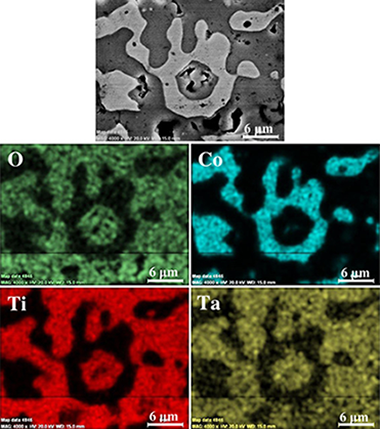
Abstract
The kinetics of the high-temperature oxidation of titanium–tantalum carbonitride-based cermets with different Ti/Ta ratios was studied. Isothermal oxidation tests were conducted under static air for 48 h at temperatures between 700 °C and 1200 °C. The oxidation satisfied the parabolic kinetics, characteristic of the existence of a protective oxide layer. The apparent activation energy suggests the rate-controlling process during oxidation is the simultaneous inward and outward diffusion of oxygen and titanium, respectively, through the formed protective layer, consisting mainly of a rutile phase. A higher Ta(V) content in the rutile decreased the oxygen diffusivity due to the reduction of oxygen vacancy concentration.
Enero, 2016 · DOI: 10.1016/j.corsci.2015.10.006
Nanotecnología en Superficies y Plasma
Quantitative analysis of Ni 2p photoemission in NiO and Ni diluted in a SiO2 matrix
Pauly, N; Yubero, F; Garcia-Garcia, FJ; Tougaard, SSurface Science, 644 (2016) 46-52 DOI: 10.1016/j.susc.2015.09.012

Abstract
In X-ray excited photoelectron emission (XPS), besides the initial excitation process, the shape and intensity of photoelectron peaks are strongly affected by extrinsic excitations due to electron transport out of the surface (including bulk and surface effects) and to intrinsic excitations due to the sudden creation of the static core hole. To make an accurate quantitative interpretation of features observed in XPS, these effects must be included in the theoretical description of the emitted photoelectron spectra. It was previously shown [N. Pauly, S. Tougaard, F. Yubero, Surf. Sci. 620 (2014) 17] that these three effects can be calculated by means of the QUEELS-XPS software (Quantitative analysis of Electron Energy Losses at Surfaces for XPS) in terms of effective energy-differential inelastic electron scattering cross-sections. The only input needed to calculate these cross-sections is the energy loss function of the media which is determined from analysis of Reflection Electron Energy Loss Spectra (REELS). The full XPS spectrum is then modeled by convoluting this energy loss cross-section with the primary excitation spectrum that accounts for all effects which are part of the initial photo-excitation process, i.e. lifetime broadening, spin-orbit coupling, and multiplet splitting. In this paper we apply the previously presented procedure to the study of Ni 2p photoemission in NiO and Ni diluted in a SiO2 matrix (Ni:SiO2), samples being prepared by reactive magnetron sputtering at room temperature. We observe a significant difference between the corresponding Ni 2p primary excitation spectra. The procedure allows quantifying the relative intensity of the c3d(9)L, c3d(10)L(2), and c3d(8) final states contributing to the Ni 2p photoemission spectra of the Ni2+ species in the oxide matrices. Especially, the intensity ratio in NiO between the non-local and local contributions to the 3d(9)L configuration is determined to be 2.5. Moreover the relative intensity ratio of the c3d(9)L/c3d(10)L(2)/c3d(8) configurations is found to be 1.0/0.83/0.11 for both the NiO and Ni:SiO2 samples.
Enero, 2016 · DOI: 10.1016/j.susc.2015.09.012
Materiales de Diseño para la Energía y Medioambiente
Thermal conductivity of partially graphitized biocarbon obtained by carbonization of medium-density fiberboard in the presence of a Ni-based catalyst
Orlova, TS; Parfen'eva, LS; Smirnov, BI; Gutierrez-Pardo, A; Ramirez-Rico, JPhysics of the Solid State, 58 (2016) 208-214 DOI: 10.1134/S1063783416010236
Abstract
The thermal conductivity k and resistivity rho of biocarbon matrices, prepared by carbonizing medium-density fiberboard at T (carb) = 850 and 1500A degrees C in the presence of a Ni-based catalyst (samples MDF-C( Ni)) and without a catalyst (samples MDF-C), have been measured for the first time in the temperature range of 5-300 K. X-ray diffraction analysis has revealed that the bulk graphite phase arises only at T (carb) = 1500A degrees C. It has been shown that the temperature dependences of the thermal conductivity of samples MDFC- 850 and MDF-C-850(Ni) in the range of 80-300 K are to each other and follow the law of k(T) similar to T (1.65), but the use of the Ni-catalyst leads to an increase in the thermal conductivity by a factor of approximately 1.5, due to the formation of a greater fraction of the nanocrystalline phase in the presence of the Ni-catalyst at T (carb) = 850A degrees C. In biocarbon MDF-C-1500 prepared without a catalyst, the dependence is k(T) similar to T (1.65), and it is controlled by the nanocrystalline phase. In MDF-C-1500(Ni), the bulk graphite phase formed increases the thermal conductivity by a factor of 1.5-2 compared to the thermal conductivity of MDF-C-1500 in the entire temperature range of 5-300 K; k(T = 300 K) reaches the values of similar to 10 W m(-1) K-1, characteristic of biocarbon obtained without a catalyst only at high temperatures of T (carb) = 2400A degrees C. It has been shown that MDF-C-1500(Ni) in the temperature range of 40aEuro'300 K is characterized by the dependence, k(T) similar to T (1.3), which can be described in terms of the model of partially graphitized biocarbon as a composite of an amorphous matrix with spherical inclusions of the graphite phase.
Enero, 2016 · DOI: 10.1134/S1063783416010236
Materiales de Diseño para la Energía y Medioambiente
Influence of temperature and time on the Eu3+ reaction with synthetic Na-Mica-n (n=2 and 4)
Garcia-Jimenez, MJ; Cota, A; Osuna, FJ; Pavon, E; Alba, MDChemical Engineering Journal, 284 (2016) 1174-1183 DOI: 10.1016/j.cej.2015.09.077
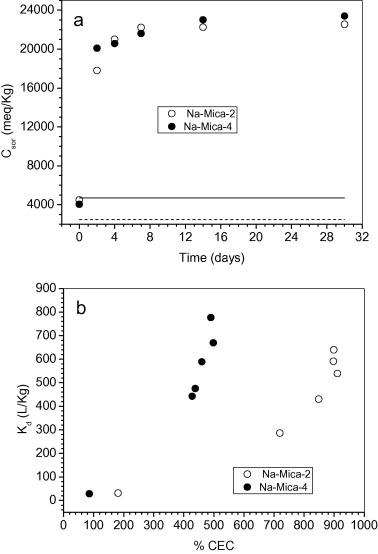
Abstract
Bentonite is accepted as the best clay material for the engineered barrier of Deep Geological Repositories (DGRs). The performance of clay as the main component of the engineered barrier in the DGR has been intensively studied and the structure of the selected clay mineral play a crucial role. In this sense, a new family of synthetic swelling silicates, Na-Mica-n, with tuned layer charge (n) values between 2.0 and 4.0 per unit cell has recently been synthesized and a general synthetic method has been reported. These swelling high-charge micas could be highly valuable for the decontamination of harmful cations. The ability of these micas to immobilize Eu3+ under subcritical conditions has been probed. The adsorption was in both non-specific sites (cation exchange mechanism) and specific sites (chemical reaction or surface defects adsorption). Moreover, its adsorption capacity, under the same conditions is higher than in saponite and far superior to the bentonites.
Enero, 2016 · DOI: 10.1016/j.cej.2015.09.077
2015
2015
Nanotecnología en Superficies y Plasma
"In Operando" X-ray Absorption Spectroscopy Analysis of Structural Changes During Electrochemical Cycling of WO3 and WxSiyOz Amorphous Electrochromic Thin Film Cathodes
Garcia-Garcia, FJ; Gil-Rostra, J; Yubero, F; Espinos, JP; Gonzalez-Elipe, AR; Chaboy, JJournal of Physical Chemistry C, 119 (2015) 644-652 DOI: 10.1021/jp508377v

Abstract
This work reports a X-ray absorption spectroscopy (XAS) study under in operando conditions of the structural and chemical changes undergone by WO3 and WxSiyOz thin films used as electrochromic cathodes. The electrochromic films were prepared by magnetron sputtering deposition at oblique angles and then characterized by a large variety of techniques. The voltammograms and chronoamperometric diagrams in both aqueous and organic electrolyte media revealed a total reversibility of the electrochromic behavior, a low response time, and a high coloration efficiency for the two types of thin films. The in operando X-ray absorption study of the films working in aqueous solutions revealed that when they were electrochemically cycled the average WO distances reversibly varied by a Delta d of 0.06 and 0.08 angstrom for, respectively, WO3 and WxSiyOz. These changes are discussed by assuming the reduction of W6+ cations and the transformation of W-O double bonds into single WO bond structures during the electrochemical cycling of the films.
Enero, 2015 · DOI: 10.1021/jp508377v
Fotocatálisis Heterogénea: Aplicaciones
Study of the phenol photocatalytic degradation over TiO2 modified by sulfation, fluorination, and platinum nanoparticles photodeposition
Murcia, JJ; Hidalgo, MC; Navio, JA; Arana, J; Dona-Rodriguez, JMApplied Catalysis B: Environmental, 179 (2015) 305-312 DOI: 10.1016/j.apcatb.2015.05.040
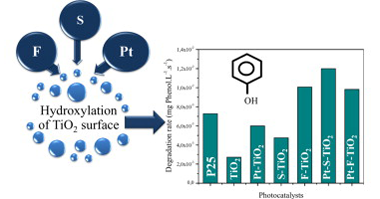
Abstract
In this work, titanium dioxide has been modified by sulfation, fluorination and simultaneous Pt nanoparticles deposition; the influence of these treatments on the photocatalytic activity of this oxide has been studied. A complete characterization study was carried out and it was observed that sulfation, fluorination and metallization were important factors influencing the TiO2 properties. The photocatalytic activity of the materials prepared was evaluated in the phenol degradation and it was found that TiO2fluorination significantly increased the phenol photodegradation rate, compared with bare TiO2, sulfated TiO2 or the commercial TiO2 Degussa P25. It was also found that Pt photodeposition on sulphated TiO2 notably increased the photocatalytic activity of this oxide, while Pt on fluorinated TiO2 did not modify significantly the phenol photodegradation rate.
Diciembre, 2015 · DOI: 10.1016/j.apcatb.2015.05.040
Propiedades mecánicas, modelización y caracterización de cerámicos avanzados
High-temperature deformation of fully-dense fine-grained boron carbide ceramics: Experimental facts and modeling
Moshtaghioun, BM; Garcia, DG; Rodriguez, ADMaterials & Design, 88 (2015) 287-293 DOI: 10.1016/j.matdes.2015.08.134
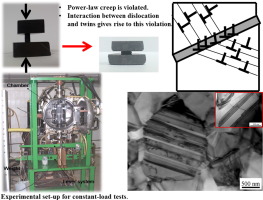
Abstract
Boron carbide ceramics are the hardest material in Nature after diamond and the cubic phase of boron nitride. Due to this fact, their room-temperature fracture properties are the object of intense research. Paradoxically, high-temperature deformation is essentially unknown, because very high temperatures and stresses are necessarily required and high-quality specimens have not been available until recently. In this paper, the high-temperature compressive creep of fine-grained boron carbide polycrystals is reported. The breakdown of the classical power-law for high-temperature plasticity in ceramics is found. An analytical model is proposed. The model assumes that deformation is produced by dislocation glide. However, since the formation of twins is energetically favorable in this material and they act as strong barriers for dislocation glide, their motion turns to become progressively more difficult as elongation proceeds. The combination of increasing twin barriers and dislocations in mutual interaction is proposed to be the mechanism for high-temperature plasticity in this material. The model is validated with the experimental results. Final elongation of boron carbide specimens is reported to be over 100%, although this material cannot be described as a superplastic ceramic.
Diciembre, 2015 · DOI: 10.1016/j.matdes.2015.08.134
Ceramics from the Alcazar Palace in Seville (Spain) dated between the 11th and 15th centuries: Compositions, technological features and degradation processes
Garofano, I; Robador, MD; Perez-Rodriguez, JL; Castaing, J; Pacheco, C; Duran, AJournal of the European Ceramic Society, 35 (2015) 4307-4319 DOI: 10.1016/j.jeurceramsoc.2015.07.033
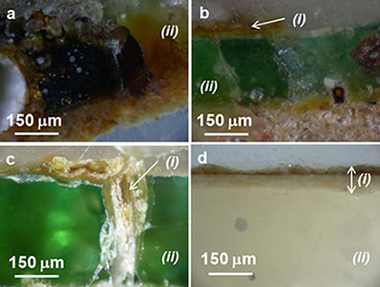
Abstract
For the purpose of chemical characterization, a selection of 29 ceramic fragments from the 11th to 15th century has been made from materials excavated in the Seville Alcazar Palace. The PIXE elemental analysis results indicated that the ceramic bodies can be divided into four groups. The XRD identification of the phases present in the bodies revealed differences in the firing temperatures. The PIXE analysis of the glazes revealed variable PbO and SnO2 contents. The latter component was not detected in all the glazes. Cu, Co, Mn, Fe and Sb elements were associated with green, blue, black and yellow colours, respectively. Some glazes were covered by iridescent layers constituted by lead carbonate and phosphates due to alteration of the glazes. It was also possible to detail the microstructure and composition of the ultimate surface layers responsible for the lustre effect observed in two of the ceramic samples using PIXE and Rutherford backscattering spectrometry (RBS).
Diciembre, 2015 · DOI: 10.1016/j.jeurceramsoc.2015.07.033
Nanotecnología en Superficies y Plasma
Optical properties of zirconium oxynitride films: The effect of composition, electronic and crystalline structures
Carvalho, P; Borges, J; Rodrigues, MS; Barradas, NP; Alves, E; Espinos, JP; Gonzalez-Elipe, AR; Cunha, L; Marques, L; Vasilevskiy, MI; Vaz, FApplied Surface Science, 358 (2015) 660-669 DOI: 10.1016/j.apsusc.2015.09.129
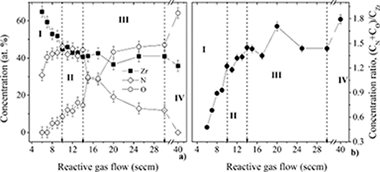
Abstract
This work is devoted to the investigation of zirconium oxynitride (ZrOxNy) films with varied optical responses prompted by the variations in their compositional and structural properties. The films were prepared by dc reactive magnetron sputtering of Zr, using Ar and a reactive gas mixture of N-2 + O-2 ( 17:3). The colour of the films changed from metallic-like, very bright yellow-pale and golden yellow, for low gas flows to red-brownish for intermediate gas flows. Associated to this colour change there was a significant decrease of brightness. With further increase of the reactive gas flow, the colour of the samples changed from red-brownish to dark blue or even to interference colourations. The variations in composition disclosed the existence of four different zones, which were found to be closely related with the variations in the crystalline structure. XRD analysis revealed the change from a B1 NaCl face-centred cubic zirconium nitride-type phase for films prepared with low reactive gas flows, towards a poorly crystallized over-stoichiometric nitride phase, which may be similar to that of Zr3N4 with some probable oxygen inclusions within nitrogen positions, for films prepared with intermediate reactive gas flows. For high reactive gas flows, the films developed an oxynitride-type phase, similar to that of gamma-Zr2ON2 with some oxygen atoms occupying some of the nitrogen positions, evolving to a ZrO2 monoclinic type structure within the zone where films were prepared with relatively high reactive gas flows. The analysis carried out by reflected electron energy loss spectroscopy (REELS) revealed a continuous depopulation of the d-band and an opening of an energy gap between the valence band (2p) and the Fermi level close to 5 eV. The ZrN-based coatings (zone land II) presented intrinsic colourations, with a decrease in brightness and a colour change from bright yellow to golden yellow, red brownish and dark blue. Associated to these changes, there was also a shift of the reflectivity minimum to lower energies, with the increase of the non-metallic content. The samples lying in the two last zones (zone III, oxynitride and zone IV, oxide films) revealed a typical semi-transparent-optical behaviour showing interference-like colourations only due to the complete depopulation of the d band at the Fermi level. The samples lying in these zones presented also an increase of the optical bandgap from 2 to 3.6 eV.
Diciembre, 2015 · DOI: 10.1016/j.apsusc.2015.09.129
Materiales y Procesos Catalíticos de Interés Ambiental y Energético
Cu–TiO2 systems for the photocatalytic H2 production: Influence of structural and surface support features
Obregon, S; Munoz-Batista, MJ; Fernandez-Garcia, M; Kubacka, A; Colon, GApplied Catalysis B: Environmental, 179 (2015) 468-478 DOI: 10.1016/j.apcatb.2015.05.043
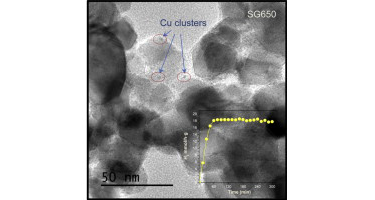
Abstract
The influence of different TiO2 supports on the Cu active species has been studied. It was found that the photocatalytic H2 evolution is highly affected by the structural and electronic features of surface Cu species. Thus, metal dispersion and oxidation state appears strongly conditioned by the structural and surface properties of the TiO2 support. We have examined three TiO2 supports prepared by different synthetic methods; sol–gel, hydrothermal and microemulsion. In addition, we have induced structural and surface modifications by sulfate pretreatment over freshly prepared TiO2 precursors and subsequent calcination. Notably different copper dispersion and oxidation state is obtained by using these different TiO2 supports. From the wide structural and surface analysis of the catalysts we are able to propose that the occurrence of highly disperse Cu2+ species, the sample surface area as well as the crystallinity of the TiO2 support are directly related to the photocatalytic activity for H2 production reaction.
Diciembre, 2015 · DOI: 10.1016/j.apcatb.2015.05.043
Nanotecnología en Superficies y Plasma
Efficient synthesis of ammonia from N-2 and H-2 alone in a ferroelectric packed-bed DBD reactor
Gomez-Ramirez, A; Cotrino, J; Lambert, RM; Gonzalez-Elipe, ARPlasma Sources Science and Technology, 24 (2015) 065011 DOI: 10.1088/0963-0252/24/6/065011
Abstract
A detailed study of ammonia synthesis from hydrogen and nitrogen in a planar dielectric barrier discharge (DBD) reactor was carried out. Electrical parameters were systematically varied, including applied voltage and frequency, electrode gap, and type of ferroelectric material (BaTiO3 versus PZT). For selected operating conditions, power consumption and plasma electron density were estimated from Lissajous diagrams and by application of the Bolsig + model, respectively. Optical emission spectroscopy was used to follow the evolution of plasma species (NH*, N*, N-2(+) and N-2*) as a function of applied voltage with both types of ferroelectric material. PZT gave both greater energy efficiency and higher ammonia yield than BaTiO3: 0.9 g NH3 kWh(-1) and 2.7% single pass N-2 conversion, respectively. This performance is substantially superior to previously published findings on DBD synthesis of NH3 from N-2 and H-2 alone. The influence of electrical working parameters, the beneficial effect of PZT and the importance of controlling reactant residence time are rationalized in a reaction model that takes account of the principal process variables
Diciembre, 2015 · DOI: 10.1088/0963-0252/24/6/065011
Materiales de Diseño para la Energía y Medioambiente
Impact of hydrothermal treatment of FEBEX and MX80 bentonites in water, HNO3 and Lu(NO3)(3) media: Implications for radioactive waste control
Osuna, FJ; Chain, P; Cota, A; Pavon, E; Alba, MDApplied Clay Science, 118 (2015) 48-55 DOI: 10.1016/j.clay.2015.08.036
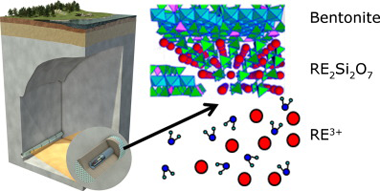
Abstract
Engineered barriers of deep geological repositories (DGR) are commonly constructed with bentonite. FEBEX and MX80 bentonites have been selected by different countries as reference materials for the sealing of repositories; however, their chemical reactivity with high-level long-lived radioactive wastes (HLRW) under subcritical conditions had not been explored before. The hydrothermal stability in neutral and acid media and chemical reactivity in contact with an actinide analogous compound were both studied. The long-range and short-range structural changes were analyzed by X-ray diffraction, nuclear magnetic resonance and scanning electron microscopy. Both bentonites have exhibited a good stability in neutral and acid media and have generated a new phase immobilizing the actinide analogous compound. The extent of the chemical reaction is higher in MX80 bentonite than in FEBEX bentonite.
Diciembre, 2015 · DOI: 10.1016/j.clay.2015.08.036
Materiales Ópticos Multifuncionales
Design and realization of transparent solar modules based on luminescent solar concentrators integrating nanostructured photonic crystals
Jimenez-Solano, A; Delgado-Sanchez, JM; Calvo, ME; Miranda-Munoz, JM; Lozano, G; Sancho, D; Sanchez-Cortezon, E; Miguez, HProgress in Photovoltaics, 23 (2015) 1785-1792 DOI: 10.1002/pip.2621
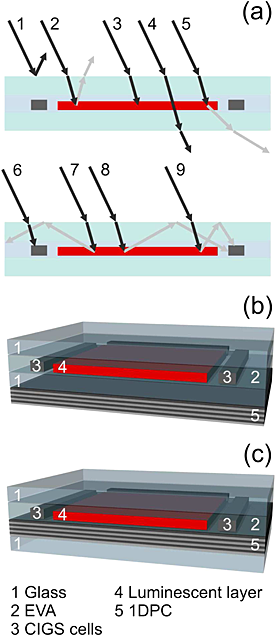
Abstract
Herein, we present a prototype of a photovoltaic module that combines a luminescent solar concentrator integrating one-dimensional photonic crystals and in-plane CuInGaSe2 (CIGS) solar cells. Highly uniform and wide-area nanostructured multilayers with photonic crystal properties were deposited by a cost-efficient and scalable liquid processing amenable to large-scale fabrication. Their role is to both maximize light absorption in the targeted spectral range, determined by the fluorophore employed, and minimize losses caused by emission at angles within the escape cone of the planar concentrator. From a structural perspective, the porous nature of the layers facilitates the integration with the thermoplastic polymers typically used to encapsulate and seal these modules. Judicious design of the module geometry, as well as of the optical properties of the dielectric mirrors employed, allows optimizing light guiding and hence photovoltaic performance while preserving a great deal of transparency. Optimized in-plane designs like the one herein proposed are of relevance for building integrated photovoltaics, as ease of fabrication, long-term stability and improved performance are simultaneously achieved.
Diciembre, 2015 · DOI: 10.1002/pip.2621
Reactividad de Sólidos
Microstructure and impedance spectroscopy of 3YTZP/SWNT ceramic nanocomposites
Poyato, R; Macias-Delgado, J; Gallardo-Lopez, A; Munoz, A; Dominguez-Rodriguez, ACeramics International, 41 (2015) 12861-12868 DOI: 10.1016/j.ceramint.2015.06.123
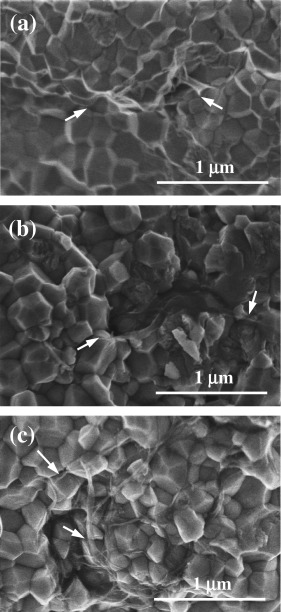
Abstract
This work provides new insights on microstructure and electrical properties of 3 mol% Y2O3-ZrO2 (3YTZP) composites with 0.5, 1, and 1.5 vol% single walled carbon nanotubes (SWNTs). The composites were spark plasma sintered (SPS) in identical conditions at 1250 degrees C from powder prepared by two different processing routines, with the aim of optimizing the SWNTs dispersion throughout the ceramic matrix. High densification and submicrometric grain size were achieved in all the composites. Electrical properties of the composites were characterized in a wide temperature range, and modeling of the impedance properties was approached by means of an equivalent circuit that allows separation of the individual SWNT bundles contribution to resistance from the resistance due to junctions between bundles. Effects of the homogeneous distribution of SWNTs at the ceramic grain boundaries on the crystalline phases, percolation threshold, total conductivity and evolution of junctions' resistivity with temperature were analyzed and discussed.
Diciembre, 2015 · DOI: 10.1016/j.ceramint.2015.06.123
Nanotecnología en Superficies y Plasma
Plasma reforming of methane in a tunable ferroelectric packed-bed dielectric barrier discharge reactor
Montoro-Damas, AM; Brey, JJ; Rodriguez, MA; Gonzalez-Elipe, AR; Cotrino, JJournal of Power Sources, 296 (2015) 268-275 DOI: 10.1016/j.jpowsour.2015.07.038
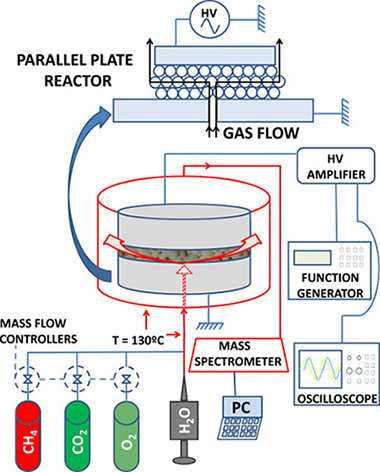
Abstract
In a tunable circular parallel plate dielectric barrier discharge reactor with pellets of a ferroelectric material separating the electrodes we investigate the plasma reforming of methane trying to maximize both the reaction yield and the energetic efficiency of the process. The geometrical configuration of the reactor (gap between electrodes, active electrode area) and the ferroelectric pellet size have been systematically varied to determine their influence on the process efficiency. The comparison between wet (with H2O as reactant), oxidative (with O2), and dry (with CO2) reforming reactions reveals a higher efficiency for the former with CO + H2 as main reaction products. The maximum energetic efficiency EE, defined as the produced number of litres of H2 per kWh, found for optimized working conditions at low-level applied power is higher than the up to date best-known results. A comprehensive discussion of the influence of the different parameters affecting the reaction yield is carried out.
Noviembre, 2015 · DOI: 10.1016/j.jpowsour.2015.07.038
Materiales Nanoestructurados y Microestructura
Atomic scale characterization of SiO2/4H-SiC interfaces in MOSFETs devices
Beltran, AM; Duguay, S; Strenger, C; Bauer, AJ; Cristiano, F; Schamm-Chardon, SSolid State Communications, 221 (2015) 28-32 DOI: 10.1016/j.ssc.2015.08.017
Abstract
The breakthrough of 4H-SiC MOSFETs is stemmed mainly due to the mobility degradation in their channel in spite of the good physical intrinsic material properties. Here, two different n-channel 4H-SiC MOSFETs are characterized in order to analyze the elemental composition at the SiC/SiO2 interface and its relationship to their electrical properties. Elemental distribution analyses performed by EELS reveal the existence of a transition layer between the SiC and the SiO2 regions of the same width for both MOSFETs despite a factor of nearly two between their electron mobility. Additional 3D compositional mapping by atom probe tomography corroborates these results, particularly the absence of an anomalous carbon distribution around the SiC/SiO2interface.
Noviembre, 2015 · DOI: 10.1016/j.ssc.2015.08.017
Fotocatálisis Heterogénea: Aplicaciones
Simultaneous Production of CH4 and H-2 from Photocatalytic Reforming of Glucose Aqueous Solution on Sulfated Pd-TiO2 Catalysts
Vaiano, V; Iervolino, G; Sarno, G; Sannino, D; Rizzo, L; Mesa, JJM; Hidalgo, MC; Navio, JAOil & Gas Science and Technology-Revue D IFP Energies Nouvelles, 70 (2015) 891-902 DOI: 10.2516/ogst/2014062
Abstract
In this work, the simultaneous production of CH4 and H-2 from photocatalytic reforming of glucose aqueous solution on Pd-TiO2 catalysts under UV light irradiation by Light-Emitting Diodes (LED) was investigated. The Pd-TiO2 catalysts were prepared by the photodeposition method. The Pd content was in the range 0.5-2 wt% and a photodeposition time in the range 15-120 min was used. Pd-TiO2 powders were extensively characterized by X-Ray Diffraction (XRD), SBET, X-Ray Fluorescence spectrometry (XRF), UV-Vis Diffuse Reflectance Spectra (UV-Vis DRS), TEM and X-Ray Photoelectron Spectroscopy (XPS). It was found that the lower Pd loading (0.5 wt%) and 120 min of photodeposition time allowed us to obtain homogeneously distributed metal nanoparticles of small size; it was also observed that the increase in the metal loading and deposition time led to increasing the Pd-0 species effectively deposited on the sulfated TiO2 surface. Particle size and the oxidation state of the palladium were the main factors influencing the photocatalytic activity and selectivity. The presence of palladium on the sulfated titania surface enhanced the H-2 and CH4 production. In fact, on the catalyst with 0.5 wt% Pd loading and 120 min of photodeposition time, H-2 production of about 26 lmol was obtained after 3 h of irradiation time, higher than that obtained with titania without Pd (about 8.5 lmol). The same result was obtained for the methane production. The initial pH of the solution strongly affected the selectivity of the system. In more acidic conditions, the production of H-2 was enhanced, while the CH4 formation was higher under alkaline conditions.
Noviembre, 2015 · DOI: 10.2516/ogst/2014062
Green pigments of Roman mural paintings from Seville Alcazar
Perez-Rodriguez, JL; de Haro, MDJ; Siguenza, B; Martinez-Blanes, JMApplied Clay Science, 116 (2015) 211-219 DOI: 10.1016/j.clay.2015.03.016
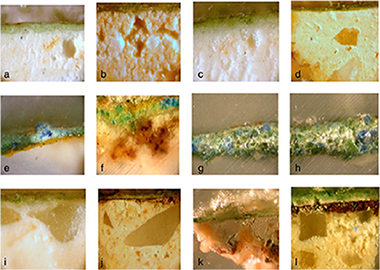
Abstract
We report here a study of 30 fragments of green wall paintings from Roman times found in the Patio de Banderas excavation in Seville Alcazar. The sample characterisation was realised using optical microscopy, colourimetry, infrared and micro-Raman spectroscopy, X-ray diffraction, and scanning electron microscopy equipped with energy dispersive X-ray spectroscopy. The study of these pigments is important because it can help determine the source or the pictorial technique used. The samples studied in this work have been divided into two groups, according to the composition of their green pigments. In the first group, celadonite has been characterised as the primary component of the green colour; chlorite was also detected. Particles constituted by chromium accompanied by aluminium, iron and zinc were found in all studied samples of this group. Chlorite and chromium oxide could also be responsible for the green colour. The presence of chromium suggested the presence of green colour pigment from Verona. In the second group, a mixture of celadonite and glauconite was detected and could be responsible for the green colour observed. The addition of refracting material such as Egyptian blue was also used. A mixture of Egyptian green and Egyptian blue together with celadonite and glauconite was also found. Four classes of intonaco were recognised and classified based upon the composition of the aggregates.
Noviembre, 2015 · DOI: 10.1016/j.clay.2015.03.016
Reactividad de Sólidos
A new model of the carbonator reactor in the calcium looping technology for post-combustion CO2 capture
Ortiz, C; Chacartegui, R; Valverde, JM; Becerra, JA; Perez-Maqueda, LAFuel, 160 (2015) 328-338 DOI: 10.1016/j.fuel.2015.07.095
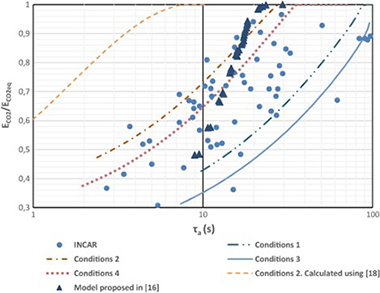
Abstract
The Ca-Looping (CaL) process is considered as a promising technology for CO2 post-combustion capture in power generation plants yielding a minor penalty on plant performance as compared with other capture technologies such as conventional amine-based capture systems. This manuscript presents a new carbonator reactor model based on lab-scale multicyclic CaO conversion results, which take into account realistic CaO regeneration conditions that necessarily involve calcination under high CO2 partial pressure and high temperature. Under these conditions, CaO conversion in the diffusion controlled stage is a relevant contribution to the carbonation degree during typical residence times. The main novelty of the model proposed in the present work is the consideration of the capture efficiency in the diffusion controlled phase of carbonation. It is demonstrated that increasing the residence time by a few minutes in the carbonator yields a significant improvement of the capture efficiency. Model predictions are shown to agree with experimental results retrieved from pilot-scale tests. The new model allows a more accurate evaluation and prediction of carbonator’s performance over a wider range of residence times. The results obtained may be relevant for the optimization of CaL operation parameters to be used in real power plants.
Noviembre, 2015 · DOI: 10.1016/j.fuel.2015.07.095
Fotocatálisis Heterogénea: Aplicaciones
Enhancement of stability and photoactivity of TiO2 coatings on annular glass reactors to remove emerging pollutants from waters
Espino-Estevez, MR; Fernandez-Rodriguez, C; Gonzalez-Diaz, OM; Navio, JA; Fernandez-Hevia, D; Dona-Rodriguez, JMChemical Engineering Journal, 279 (2015) 488-497 DOI: 10.1016/j.cej.2015.05.038
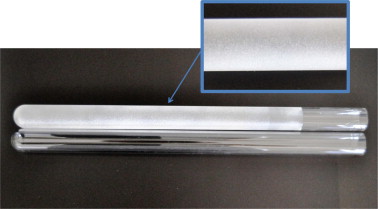
Abstract
TiO2 coatings of highly photoactive lab-made titania were prepared on the outer wall of the inner tube of a glass tubular reactor by dip-coating method. The effect of decreasing the size of the aggregates to improve adhesion and photoactivity of the coatings to degrade phenol, diclofenac and isoproturon was also investigated. Chemical disaggregation of the TiO2 particles resulted in a lower aggregate size, between 0.1 and 1 μm, than mechanical disaggregation, between 1 and 10 μm. The results of the adhesion tape test showed that either milling of aggregate material with a planetary mill or chemical stabilization of the particles were necessary to obtain TiO2 coatings on glass tube with acceptable quality to be used in water treatment applications. SEM images showed that coatings prepared after milling the TiO2 suspension were more homogeneous without surface aggregates. The degree of adhesion of the coatings after increasing the roughness of the support by abrasive blasting was also evaluated. Adhesion to the substrate was slightly lower when using the modified support. The photoactivity results showed that the coatings prepared after wet milling of catalyst during 30 min and after chemical disaggregation were more efficient in terms of degradation and mineralization when using phenol as model molecule. Subsequent studies with two emerging pollutants, diclofenac and isoproturon, also showed enhanced efficiency of these coatings. The reusability of the TiO2 coatings was also evaluated and a promising photocatalytic performance was observed with a very low variation of the decay rate after five consecutive usages.
Noviembre, 2015 · DOI: 10.1016/j.cej.2015.05.038
Nanotecnología en Superficies y Plasma - Materiales Ópticos Multifuncionales
Single-step fabrication process of 1-D photonic crystals coupled to nanocolumnar TiO2 layers to improve DSC efficiency
Gonzalez-Garcia, L; Colodrero, S; Miguez, H; Gonzalez-Elipe, AROptics Express, 23 (2015) A1642-A1650 DOI: 10.1364/OE.23.0A1642
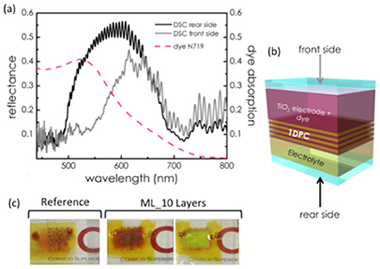
Abstract
The present work proposes the use of a TiO2 electrode coupled to a one-dimensional photonic crystal (1DPC), all formed by the sequential deposition of nanocolumnar thin films by physical vapor oblique angle deposition (PV-OAD), to enhance the optical and electrical performance of DSCs while transparency is preserved. We demonstrate that this approach allows building an architecture combining a non-dispersive 3 µm of TiO2 electrode and 1 µm TiO2-SiO2 1DPC, both columnar, in a single-step process. The incorporation of the photonic structure is responsible for a rise of 30% in photovoltaic efficiency, as compared with a transparent cell with a single TiO2 electrode. Detailed analysis of the spectral dependence of the photocurrent demonstrates that the 1DPC improves light harvesting efficiency by both back reflection and optical cavity modes confinement within the TiO2 films, thus increasing the overall performance of the cell.
Noviembre, 2015 · DOI: 10.1364/OE.23.0A1642
Materiales Ópticos Multifuncionales
Adaptable Ultraviolet Reflecting Polymeric Multilayer Coatings of High Refractive Index Contrast
Smirnov, JRC; Ito, M; Calvo, ME; Lopez-Lopez, C; Jimenez-Solano, A; Galisteo-Lopez, JF; Zavala-Rivera, P; Tanaka, K; Sivaniah, E; Miguez, HAdvanced Optical Materials, 3 (2015) 1633-1639 DOI: 10.1002/adom.201500209

Abstract
A synthetic route is demonstrated to build purely polymeric nanostructured multilayer coatings, adaptable to arbitrary surfaces, and capable of efficiently blocking by reflection a targeted and tunable ultraviolet (UV) range. Reflection properties are determined by optical interference between UV light beams reflected at the interfaces between polystyrene layers of different porosity and hence refractive index. As no dopant absorber intervenes in the shielding effect, polymer degradation effects are prevented. Alternated porosity results from the modulation of photochemical effects at the few tens of nanometers length scale, combined with the collective osmotic shock induced during the processing of the precursor diblock copolymer film. Experimental evidence of the application of this method to coat rough surfaces with smooth and conformal UV protecting films is provided.
Noviembre, 2015 · DOI: 10.1002/adom.201500209
Nanotecnología en Superficies y Plasma
"In situ" XPS studies of laser-induced surface nitridation and oxidation of tantalum
Lahoz, R; Espinos, JP; Yubero, F; Gonzalez-Elipe, AR; de la Fuente, GFJournal of Materials Research, 30 (2015) 2967-2976 DOI: 10.1557/jmr.2015.190
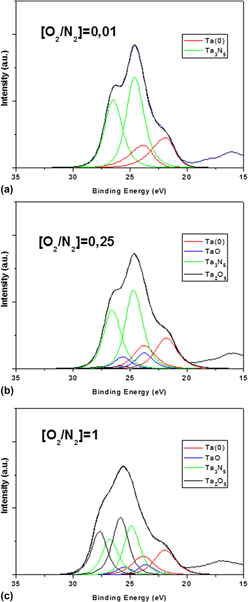
Abstract
This work studies the nitridation of Ta by laser irradiation by means of x-ray photoelectron spectroscopy. The study has been carried out under "in situ" conditions by controlling the nitrogen partial pressure, the presence of traces of oxygen, and the irradiance of the laser. It is found that a thin layer of Ta2O5 is directly obtained when irradiating in the presence of oxygen, while a Ta3N5 surface compound and some minor contributions of nonstoichiometric phases are formed in the presence of nitrogen. For O-2:N-2 mixtures at 0.1 Pa, preferential nitride formation occurs up to a ratio of 1:4, while Ta2O5 starts to be predominant for ratios above this value. The air stability of the tantalum nitride layer formed by laser irradiation and the surface topography of the irradiated metal are also studied. The possible factors determining this behavior are discussed.
Octubre, 2015 · DOI: 10.1557/jmr.2015.190
Nanotecnología en Superficies y Plasma
Amperometric magnetobiosensors using poly(dopamine)-modified Fe3O4 magnetic nanoparticles for the detection of phenolic compounds
Martin, M; Salazar, P; Campuzano, S; Villalonga, R; Pingarron, JM; Gonzalez-Mora, JLAnalytical Methods, 7 (2015) 8801-8808 DOI: 10.1039/C5AY01996F
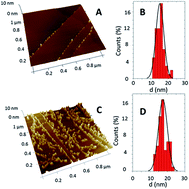
Abstract
The synthesis of poly(dopamine)-modified magnetic nanoparticles (MNPs) and their application in preparing electrochemical enzyme biosensors that are useful to detect phenolic compounds is reported in this work. MNPs of about 16 nm were synthesized by a co-precipitation method and conveniently modified with poly(dopamine). Non-modified and modified MNPs were characterized using X-ray photoelectron spectroscopy (XPS), Raman and infrared spectroscopy, X-ray diffraction (XRD) and atomic force microscopy (AFM). Horseradish peroxidase (HRP) was covalently immobilized onto the surface of the poly(dopamine)-modified MNPs via Michael addition and/or Schiff base formation and used to construct a biosensor for phenolic compounds by capturing the HRP-modified-nanoparticles onto the surface of a magnetic-modified glassy carbon electrode (GCE). Cyclic voltammetry and amperometry were used to study the electrochemical and analytical properties of the biosensor using hydroquinone (HQ) as a redox probe. Among the different phenolic compounds studied, the biosensor exhibited higher sensitivity for HQ, 1.38 A M−1 cm−2, with limits of detection and quantification of 0.3 and 1.86 μM, respectively. The analytical biosensor performance for HQ and 2-aminophenol compared advantageously with those of previous phenolic biosensors reported in the literature.
Octubre, 2015 · DOI: 10.1039/C5AY01996F
Materiales Avanzados
An improved method for determining the external specific surface area and the plasticity index of clayey samples based on a simplified method for non-swelling fine-grained soils
Garzon, E; Sanchez-Soto, PJApplied Clay Science, 115 (2015) 97-107 DOI: 10.1016/j.clay.2015.07.015
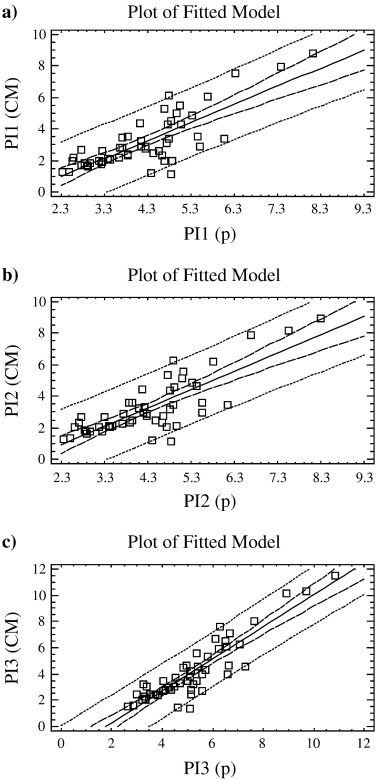
Abstract
Previous studies have used the clay content of soils for estimating the specific surface areas and different correlations have been found, including plasticity-value correlations. Based on several assumptions, Dolinar (2012) proposed a simplified method for determining the external specific surface area of non-swelling fine-grained soils. An equation relates the external specific surface area (BET-nitrogen) with percentage of clay fraction (< 2 μm), determined by hydrometer method, and plasticity index (Atterberg).
In this work, based on that simplified method, the authors have developed an improved method for determining the external specific surface area of fine-grained clay samples. Instead of percentage of clay fraction, it was proposed to use the clay mineral content estimated by XRD methods. From an analysis of previous Dolinars results, the calculated and measured values of external specific surface area were studied for a group of non-swelling and fine-grained soil samples (Dolinar's samples), five non-swelling clayey samples and data samples from the literature. Additionally, an estimation of the plasticity index (Atterberg) has been also considered in this improved method. Both these methods, simplified and improved, were tested and compared using all these samples. It demonstrated the practical application of both these methods for an estimation of external specific surface area and plasticity index. However, in the present research two models were considered to determine the specific surface areas (BET and Langmuir) and the influence of several sources of errors in these predictions was discussed. The predictions were found more accurate when specific surface area from Langmuir's model is considered. It is concluded that the present research will be useful for the prediction of external specific surface area and plasticity index of non-swelling clayey materials and to dispose of theoretical practical relationships between clay mineralogy and geotechnical properties of valuable interest.
Octubre, 2015 · DOI: 10.1016/j.clay.2015.07.015
Materiales Nanoestructurados y Microestructura - Materiales Ópticos Multifuncionales
Full solution processed mesostructured optical resonators integrating colloidal semiconductor quantum dots
Calvo, ME; Hidalgo, N; Schierholz, R; Kovacs, A; Fernandez, A; Bellino, MG; Soler-Illia, GJAA; Miguez, HNanoscale, 7 (2015) 16583-16589 DOI: 10.1039/C5NR03977K
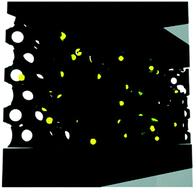
Abstract
Herein we show a solution based synthetic pathway to obtain a resonant optical cavity with embedded colloidal semiconductor quantum dots (CSQDs). The optical cavity pore network, surrounded by two dense Bragg mirrors, was designed ad hoc to selectively host the quantum dots, while uncontrolled infiltration of those in the rest of the layered structure was prevented. Coupling between the optical resonant modes of the host and the natural emission of the embedded nanoparticles gives rise to the fine tuning of the luminescence spectrum extracted from the ensemble. Our approach overcomes, without the need for an encapsulating agent and exclusively by solution processing, the difficulties that arise from the low thermal and chemical stability of the CSQDs. It opens the route to achieving precise control over their location and hence over the spectral properties of light emitted by these widely employed nanomaterials. Furthermore, as the porosity of the cavity is preserved after infiltration, the system remains responsive to environmental changes, which provides an added value to the proposed structure.
Octubre, 2015 · DOI: 10.1039/C5NR03977K
Química de Superficies y Catálisis
Synergy between gold and oxygen vacancies in gold supported on Zr-doped ceria catalysts for the CO oxidation
Laguna, OH; Perez, A; Centeno, MA; Odriozola, JAApplied Catalysis B-Environmental, 176 (2015) 385-395 DOI: 10.1016/j.apcatb.2015.04.019
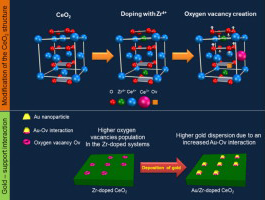
Abstract
The CO oxidation activity of 1 wt.% gold catalysts prepared by deposition-precipitation on a series of ceria doped with Zr supports was studied. The supports (10, 25 and 50 Zr at.%) were synthesized by a pseudo sol-gel method through the thermal decomposition of the corresponding metallic propionates. All the prepared solids were characterized by means of XRF, BET, XRD, Raman spectroscopy, SEM, and H-2-TPR. Solid solution was obtained in all mixed systems, while the segregation of different Ce-Zr oxides was observed for the solid with the 50 Zr at.%. The oxygen vacancies population and the amount of easier reducible Ce4+ species in the solids increase with the Zr content. No major textural or structural modifications were detected after gold deposition, although a strong Au-support interaction was generated. Such interaction is strongly influenced by the nucleation of gold deposits on the oxygen vacancies and consequently the amount of Zr inserted in the ceria network also determines the dispersion of gold. The presence of gold eases the surface reduction at lower temperatures, and as higher the amount of Zr in the gold catalysts, higher the CO conversion at low temperatures, probably due to the enhancement of the electronic transfer at the surface of the catalysts.
Octubre, 2015 · DOI: 10.1016/j.apcatb.2015.04.019
Materiales Nanoestructurados y Microestructura
Role of Y in the oxidation resistance of CrAlYN coatings
Dominguez-Meister, S; El Mrabet, S; Escobar-Galindo, R; Mariscal, A; de Haro, CJ; Justo, A; Brizuela, M; Rojas, TC; Sanchez-Lopez, JCApplied Surface Science, 363 (2015) 504-511 DOI: 10.1016/j.apsusc.2015.06.099
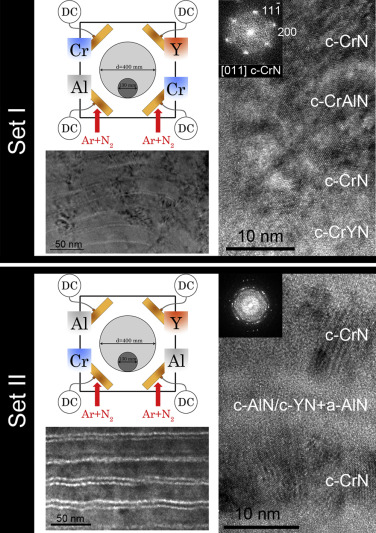
Abstract
CrAlYN coatings with different aluminum (4–12 at.%) and yttrium (2–5 at.%) contents are deposited by d.c. reactive magnetron sputtering on silicon and M2 steel substrates using metallic targets and Ar/N2 mixtures. The influence of the nanostructure and chemical elemental distribution on the oxidation resistance after heating in air at 1000 °C is studied by means of cross-sectional scanning electron microscopy (X-SEM), energy dispersive X-ray analysis (EDX), X-ray diffraction (XRD) and glow discharge optical emission spectroscopy (GD-OES). The sequential exposure to the metallic targets during the synthesis leads to a multilayer structure where concentration of metallic elements (Cr, Al and Y) is changing periodically. A good oxidation resistance is observed when Al- and Y-rich regions are separated by well-defined CrN layers, maintaining crystalline coherence along the columnar structure. This protective behavior is independent of the type of substrate and corresponds to the formation of a thin mixed (Al, Cr)-oxide scale that protects the film underneath. The GD-OES and XRD analysis have demonstrated that Y acts as a reactive element, blocking the Fe and C atoms diffusion from the steel and favoring higher Al/Cr ratio in the passivation layer after heating. The coating with Y content around 4 at.% exhibited the best performance with a thinner oxide scale, a delay in the CrN decomposition and transformation to Cr2N, and a more effective Fe and C blocking.
Octubre, 2015 · DOI: 10.1016/j.apsusc.2015.06.099
Materiales Ópticos Multifuncionales
Synergistic strategies for the preparation of highly efficient dye-sensitized solar cells on plastic substrates: combination of chemical and physical sintering
Li, Y; Yoo, K; Lee, DK; Kim, JY; Son, HJ; Kim, JH; Lee, CH; Miguez, H; Ko, MJRSC Advances, 5 (2015) 76795-76803 DOI: 10.1039/C5RA10290A
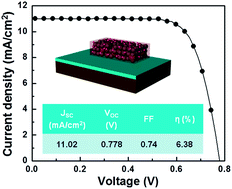
Abstract
Preparation of well-interconnected TiO2 electrodes at low temperature is critical for the fabrication of highly efficient dye-sensitized solar cells (DSCs) on plastic substrates. Herein we explore a synergistic approach using a combination of chemical and physical sintering. We formulate a binder-free TiO2 paste based on “nanoglue” as the chemical sintering agent, and use it to construct a photoelectrode on plastic by low-temperature physical compression to further improve the connectivity of TiO2 films. We systematically investigated the factors affecting the photovoltaic performance and found the conditions to achieve electron diffusion lengths as long as 25 μm and charge collection efficiencies as high as 95%, as electrochemical impedance spectroscopy measurements indicate. We apply this approach to obtain a DSC deposited on plastic displaying 6.4% power conversion efficiency based on commercial P25 titania particles.
Octubre, 2015 · DOI: 10.1039/C5RA10290A
Reactividad de Sólidos
Structural, Optical, and Electrical Characterization of Yttrium-Substituted BiFeO3 Ceramics Prepared by Mechanical Activation
Perejon, A; Gil-Gonzalez, E; Sanchez-Jimenez, PE; Criado, JM; Perez-Maqueda, LAInorganic Chemistry, 54 (2015) 9876-9884 DOI: 10.1021/acs.inorgchem.5b01654
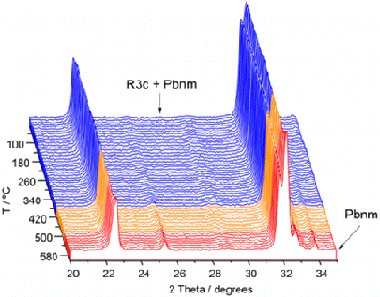
Abstract
Ceramics of Bi1-xYxFeO3 solid solutions (x = 0.02, 0.07, and 0.10) have been prepared by mechanical activation followed by sintering. The effect of yttrium content on the structural, electrical, and optical properties of the materials has been studied. Thus, single-phase solid solutions with rhombohedral R3c structure have been achieved for x = 0.02 and 0.07, while for x = 0.10 the main R3c phase has been detected together with a small amount of the orthorhombic Pbnm phase. Multiferroic properties of the samples, studied by differential scanning calorimetry (DSC), showed that both T-N and T-C (temperatures of the antiferromagnetic paramagnetic and ferroelectric-paraelectric transitions, respectively) decrease with increasing yttrium content. The nature of the ferroelectric paraelectric transition has been studied by temperature-dependent X-ray diffraction (XRD), which revealed rhombohedral R3c to orthorhombic Pbnm phase transitions for x = 0.07 and 0.10. On the other hand, for x = 0.02 the high-temperature phase was indexed as Pnma. Optical properties of the samples, as studied by diffuse reflectance spectroscopy, showed low optical band gap that decreases with increasing yttrium content. Prepared ceramics were highly insulating at room temperature and electrically homogeneous, as assayed by impedance spectroscopy, and the conductivity increased with x.
Octubre, 2015 · DOI: 10.1021/acs.inorgchem.5b01654
Química de Superficies y Catálisis
Oxodiperoxomolybdenum complex immobilized onto ionic liquid modified SBA-15 as an effective catalysis for sulfide oxidation to sulfoxides using hydrogen peroxide
Carrasco, Carlos J.; Montilla, Francisco; Bobadilla, Luis; Ivanova, Svetlana; Antonio Odriozola, Jose; Galindo, AgustinCatalysis Today, 255 (2015) 102-108 DOI: 10.1016/j.cattod.2014.10.053
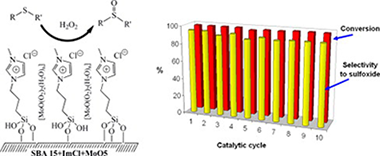
Abstract
A supported ionic-liquid-phase (SILP) was prepared by the reaction of 1-methyl-3-(3-(triethoxysilyl) propyl)-1H-imidazol-3-ium chloride with a mesoporous SBA-15 silica and then an oxodiperoxomolybdenum complex was immobilized onto the obtained SILP. The resulting material, identified as SBA-15 + ImCl+ MoO5, was characterized by solid state NMR (H-1, C-13 and Si-29), and their textural and thermogravimetric properties were determined. The SBA-15 + ImCl+ MoO5 material was investigated as catalyst for the oxidation of methylphenylsulfide, as model reaction, with aqueous hydrogen peroxide as oxidant at room temperature. The presence of the molybdenum species was crucial for achieving good conversions and methanol was selected as the best solvent (conversion of 95% and selectivity toward sulfoxide 98%). The optimized reaction conditions were applied for the oxidation of several selected sulfides. In general, good catalytic activity and selectivity to sulfoxide were obtained and, remarkably, the selectivity toward sulfoxide is higher than those observed in the study of the same process carried out in [C(4)min][PF6] (C(4)mim = 1-buty1-3-methylimidazolium) and catalyzed by a molecular molybdenum complex, under the same reaction conditions. The importance of the IL-functionalization in the SBA-15 material was evidenced by recycling experiments. The SBA-15 + ImCl+ MoO5 catalyst was used for the sulfoxidation of the methylphenylsulfide substrate for ten reaction cycles without a significant change in conversion, selectivity to sulfoxide and molybdenum content.
Octubre, 2015 · DOI: 10.1016/j.cattod.2014.10.053
- ‹ anterior
- 22 of 37
- siguiente ›




